🌀 Scroll I: The Bardo & Clear Light Beyond the Veil of Samsara: Enter the Bardo Where the Soul Meets Its Radiant Mirror
⚠️ Buddhist Diversity Disclaimer
This teaching draws from Theravāda, Mahāyāna, and Vajrayāna traditions. Interpretations of rebirth, nirvāṇa, and bardo vary across schools (e.g., Theravāda’s anattā focus, Mahāyāna’s Pure Land devotion, Vajrayāna’s visionary practices). This is one thread, not the whole Dharma.
🌿 Chapter 1: The Wheel Turns
Anamataggoyaṃ saṃsāro, pubbā koṭi na paññāyati.
“Samsāra has no beginning that can be seen.” Saṃyutta Nikāya
In Buddhist cosmology, reality is not linear. It spirals.
This spiral is called Samsāra, the Wheel of Becoming, where beings move through lifetimes across six realms: god, demigod, human, animal, hungry ghost, and hell-being. Each realm is both literal and symbolic: places of rebirth, but also states of mind we drift through daily.
The wheel spins because of karma, intentional actions and taṇhā, craving. Like gravity, karma pulls. Like fire, it burns. We chase, we cling, we become and so we are reborn.
But this cycle is not eternal law, it is conditioned. What is conditioned can be unconditioned. The Buddha did not teach how to make a better ride on the wheel, he taught how to step off it.
Theravāda emphasises anattā (no-self), viewing rebirth as a process without a permanent soul, while Mahāyāna’s Pure Land tradition trusts in Amitābha Buddha’s vow to guide devotees to a rebirth-free paradise. Vajrayāna, our focus in Scroll III, illuminates the bardo’s visionary path.
For the Gnostic seeker, this teaching resonates: the world is not a blessing, but a trap of recurrence. Liberation is not ascension through the realms, but departure from the cycle itself.
⚡ TL;DR The Wheel Turns
- Samsāra is the endless cycle of birth, death, and rebirth
- It is powered by karma (intentional action) and taṇhā (craving)
- The six realms are psychological states as well as cosmic ones
- Awakening (nirvāṇa) means stepping off the wheel, not perfecting the ride
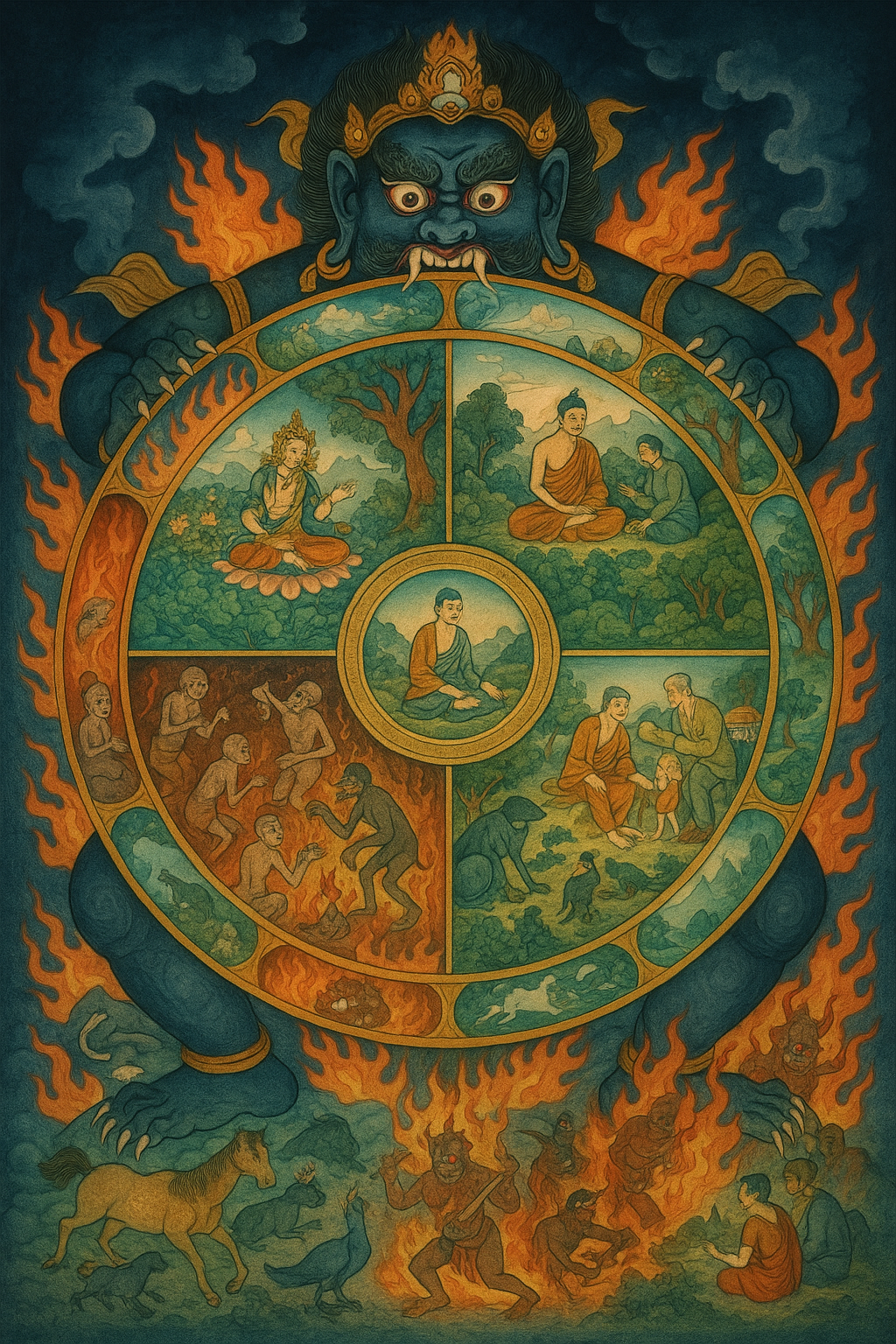
🔥 Chapter 2: The Karma Machine
Cetanāhaṁ, bhikkhave, kammaṁ vadāmi.
“It is intention, monks, that I call karma.” Anguttara Nikāya
Karma is not fate. It is not divine punishment, nor cosmic reward. In the Buddha’s words: karma is intention.
Every thought, word, and action plants a seed, shaping the conditions that follow. This is not metaphysics, it is the observable architecture of becoming.
Like a machine, karma generates momentum. The wheel turns not by accident, but because we fuel it: with craving, resistance, grasping, fear.
But karma is not static. Its engine can be stopped. In fact, that’s the aim of the Buddhist path, to end the cycle by ending the fuel. To act without clinging. To do without becoming.
For Gnostic seekers, this resembles the Archonic system, a spiritual mechanism built on false desire and illusion. Karma is the script of the false world. Liberation requires stepping beyond the script entirely.
⚡ TL;DR The Karma Machine
- Karma means intention, not fate, judgement, or cosmic reward
- Every act shapes future experience, like seeds growing into fruit
- The “machine” of becoming is driven by craving and aversion
- Freedom begins when we stop planting karmic seeds
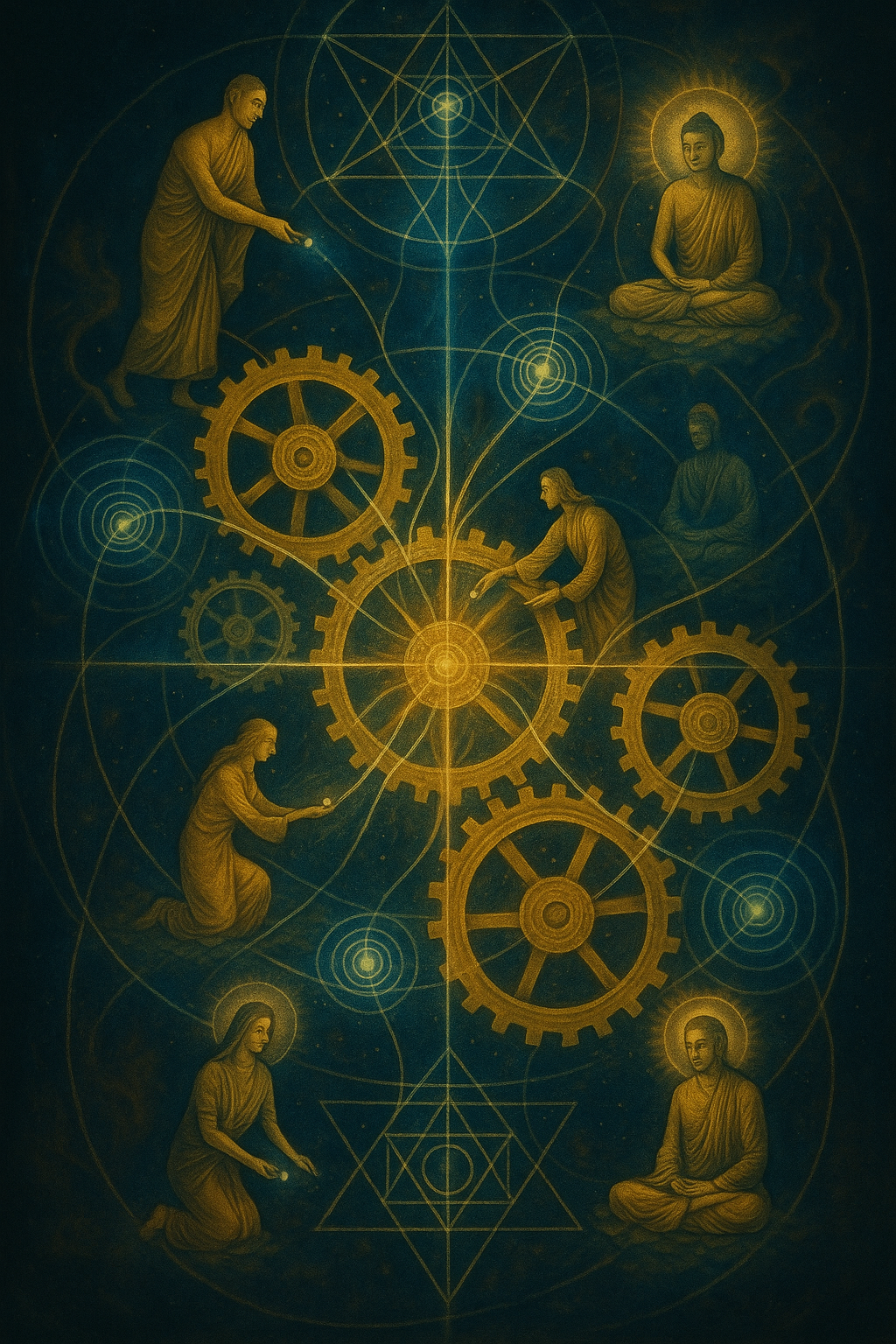
🌫️ Chapter 3: The Realm-Mirror
Saṃsāraṁ nāma loko, dukkhasamudayagāminī paṭipadā.
“This world of samsāra is a cycle; its path leads to the arising of suffering.” Dhammapada
In Buddhist cosmology, the six realms of existence are often described as literal rebirths, but they are also mirrors of mind. You do not need to die to visit them. You pass through them daily.
They are:
- Deva (God) Realm — pleasure, distraction, spiritual pride
- Asura (Demigod) Realm — jealousy, egoic striving, competition
- Human Realm — balance of joy and suffering, potential for awakening
- Animal Realm — instinct, fear, survival, ignorance
- Hungry Ghost Realm — addiction, craving, insatiable desire
- Hell Realm — rage, agony, torment, hatred
These are not punishments, they are reflections. Each realm reveals a dominant state of consciousness. Each one is a teaching. And every moment is a crossroads: which realm are you in?
The Buddha taught that the human realm is the rarest, because it balances clarity and suffering. It offers the best chance for awakening. Gnostics would call it the midpoint of the labyrinth, where the false light and true light are both visible.
To understand the realms is to understand the self. To pass through them consciously is to begin breaking the wheel.
⚡ TL;DR The Realm-Mirror
- The six realms are both cosmic and psychological, we visit them in life
- Each realm mirrors a dominant state: pride, jealousy, craving, fear, rage, or clarity
- The human realm holds the rare opportunity to awaken
- Every moment is a shift, awareness reveals your current realm
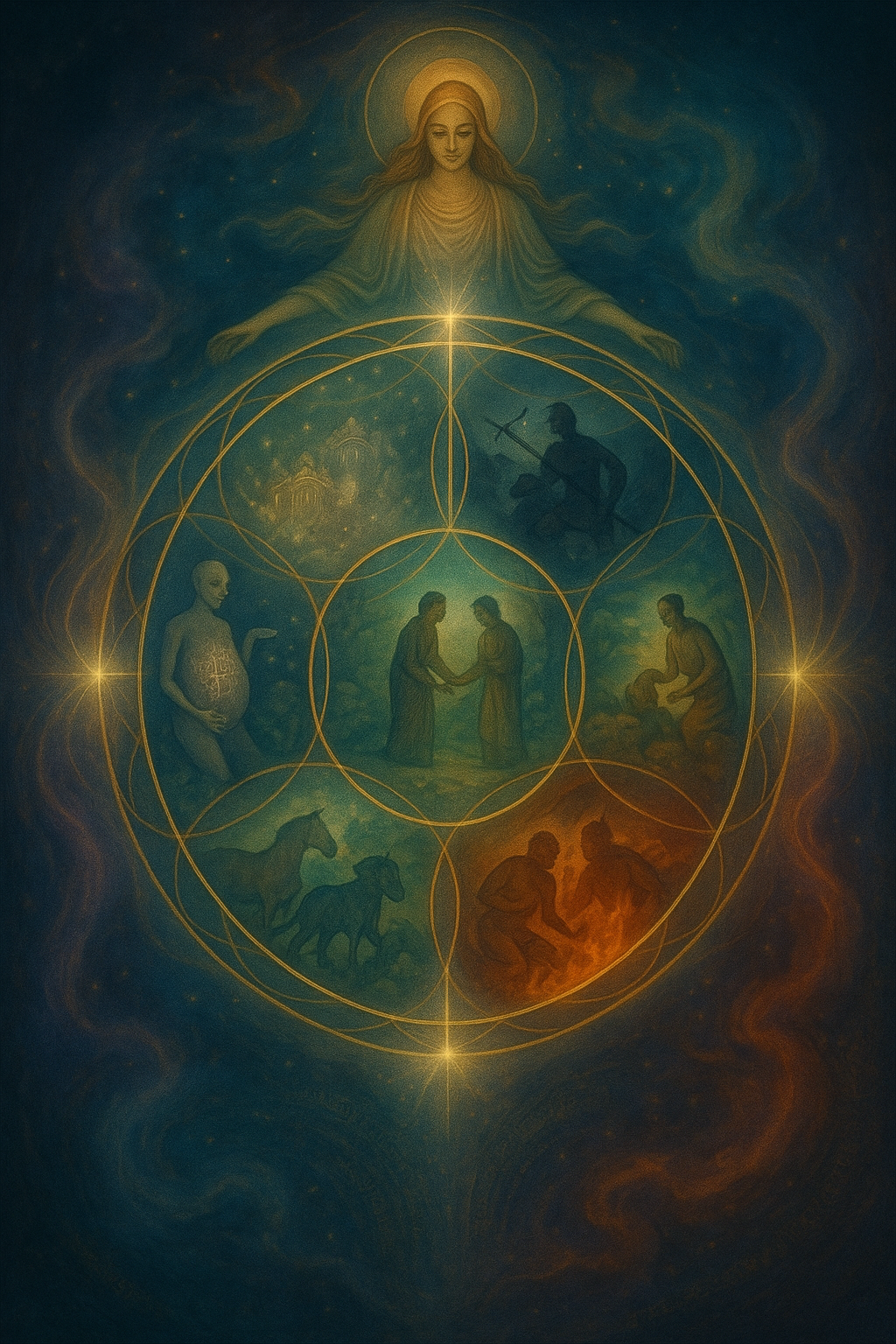
🔗 Chapter 4: The Breaking of the Chain
Imasmiṁ sati idaṁ hoti, imassuppādā idaṁ uppajjati.
“When this is, that is. From the arising of this, that arises.” The Buddha, on Dependent Origination
The Buddha taught that suffering is not random, it is structured. A patterned chain. A recursive loop.
This structure is called Paṭicca-Samuppāda, Dependent Origination. It describes the twelve interlinked links of becoming, each giving rise to the next:
- Ignorance (avijjā) — Not knowing the true nature of reality. The primal blindness to impermanence, non-self, and the nature of suffering. It is the root illusion that sets the cycle in motion.
- Volitional Formations (saṅkhāra) — Conditioned impulses or karmic actions, shaped by ignorance. These are the seeds, mental, verbal, physical, that shape future experiences.
- Consciousness (viññāṇa) — Awareness conditioned by past karma. This is not pure awareness, but a specific stream of perception tied to karmic tendencies.
- Name and Form (nāma-rūpa) — The arising of body and mind: sensation, perception, thought, identity. Consciousness crystallises into a new being.
- Six Sense Spheres (saḷāyatana) — The development of the five senses and the mind as a sixth. The apparatus of perception is re-established.
- Contact (phassa) — When the senses meet objects, contact arises, a spark between subject and object.
- Feeling (vedanā) — From contact arises feeling: pleasant, unpleasant, or neutral. This is the raw experience of sensation.
- Craving (taṇhā) — Feeling gives rise to desir, the thirst to possess, to avoid, or to repeat. The mind begins to reach.
- Clinging (upādāna) — Craving intensifies into attachment. The mind grabs onto ideas, identities, objects, relationships.
- Becoming (bhava) — Clinging sets into motion the process of becoming, the karmic momentum that conditions the next existence.
- Birth (jāti) — The arising of a new life, form, or identity, not only literal birth, but any moment we "become" something again.
- Decay and Death (jarāmaraṇa) — Every arising ends. With birth comes aging, dissolution, and death, followed by grief, lamentation, and the wheel beginning again.
This is the engine of Samsāra, a loop that creates identity, rebirth, and suffering. But it is not eternal. Each link is conditional. If you break one link, the chain stops.
Gnostic teachings echo this. The soul, caught in the Archons’ illusions, descends through layers of ignorance and craving. But at any gate, it can remember. It can turn back.
To see the links is to weaken them. To see the wheel is to begin stepping off.
⚡ TL;DR The Breaking of the Chain
- Dependent Origination maps the cycle of rebirth as 12 linked causes
- The cycle begins with ignorance and ends in death, then restarts
- Each link is conditional, awareness at any point breaks the chain
- Gnostics mirror this with the soul’s descent into illusion and ascent through memory
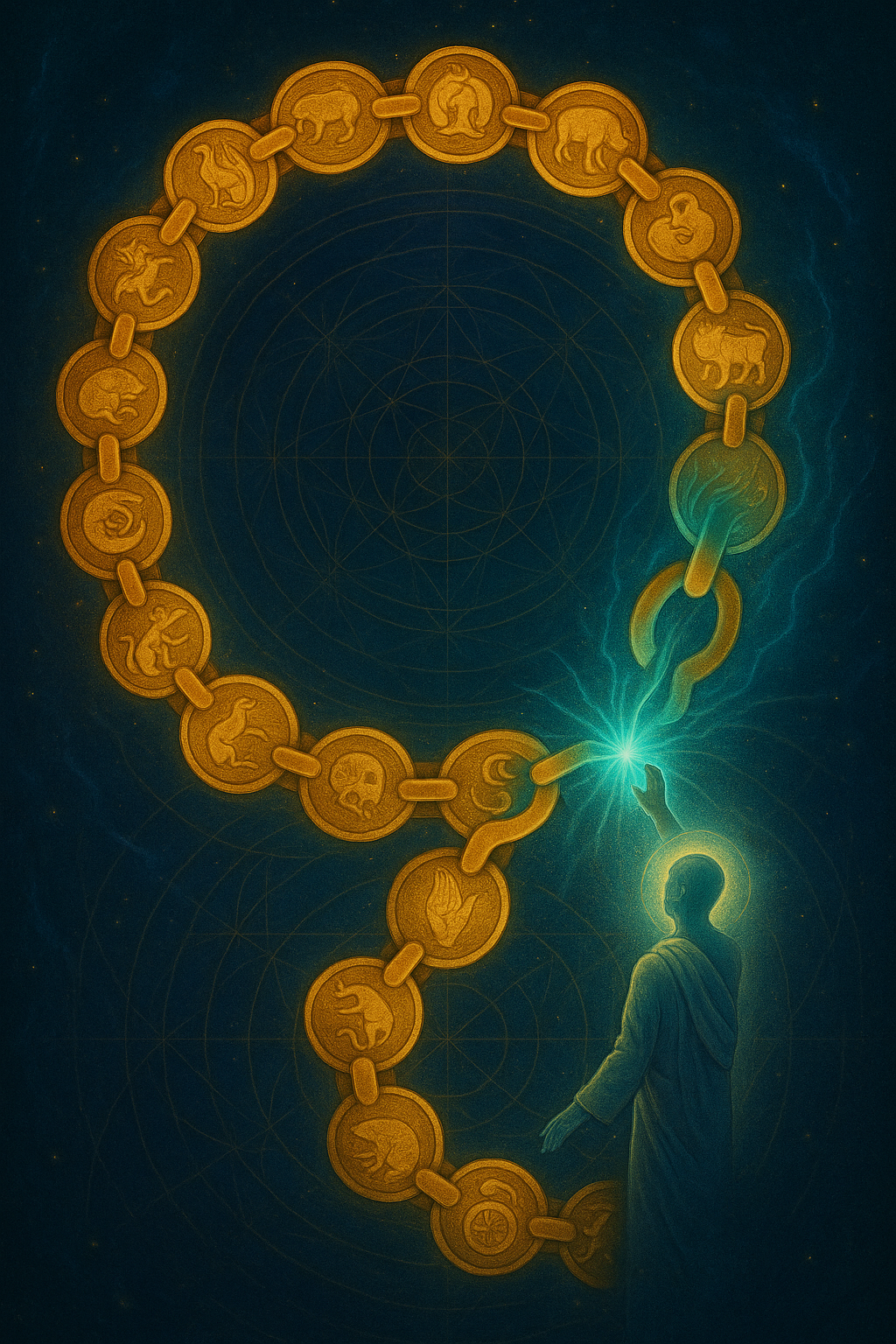
🌑 Chapter 5: The Great Forgetting
Avijjā paccayā saṅkhārā
“With ignorance as condition, formations arise.” Paṭicca-Samuppāda, Link 1
All things begin in forgetting.
In Buddhism, the first link of the cycle of rebirth is avijjā, ignorance. Not mere lack of knowledge, but the primordial blindness to the truth of impermanence, non-self, and suffering.
It is the ignorance that believes in a fixed “I,” that grasps for permanence in the impermanent, that mistakes craving for joy and the world for a home. It is this illusion that births karma, and the entire wheel turns from there.
The Gnostic vision mirrors this: we are born not in innocence, but in amnesia. The soul forgets its origin in the Pleroma. Memory fades. The divine spark is buried. The veil falls.
This is the Great Forgetting, and every birth is a repetition of it.
⚡ TL;DR The Great Forgetting
- Ignorance (avijjā) is the first cause in the cycle of rebirth
- It means forgetting the true nature of reality: impermanence, non-self, and suffering
- This ignorance births karma and sets the wheel of samsāra spinning
- In Gnostic thought, it mirrors the soul’s loss of divine memory and descent into illusion
- Awakening begins when remembering begins, to see clearly is to return
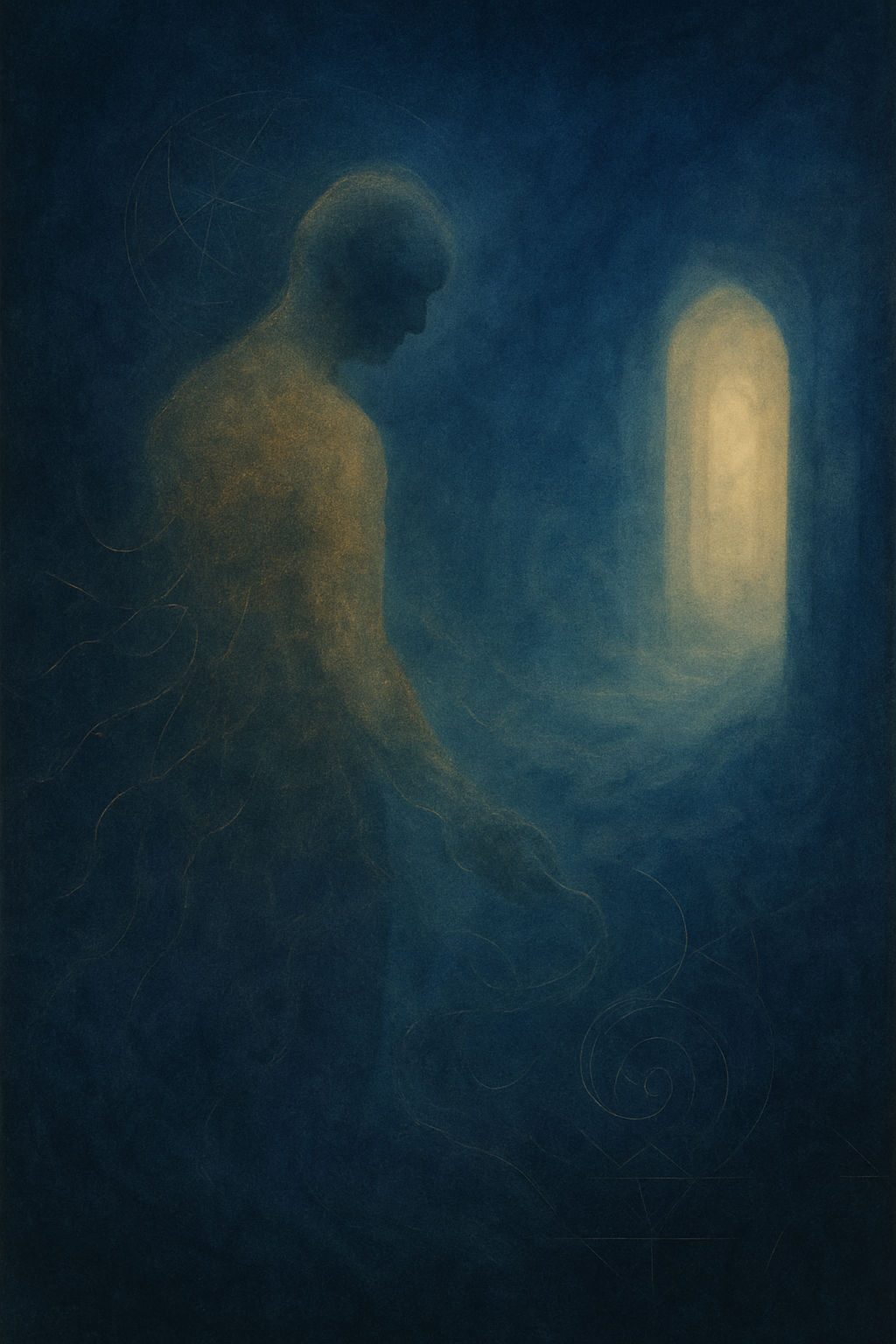
🪞 Chapter 6: The Mirror of the Realms
Yathāpi bhamaro pupphaṃ, vaṇṇagandhamaheṭhayaṃ,
paleti rasamādāya, evaṃ gāme munī care.
“Like a bee gathering nectar without harming the flower, live in the world without attachment.” Dhammapada 49
In Buddhist cosmology, existence spans six realms, each shaped by karma, each offering a distorted mirror of the mind. These realms are:
- Deva (God) Realm —a realm of bliss and beauty, but sedated by spiritual pride and complacency
- Asura (Demi-God) Realm — dominated by jealousy, rivalry, and restless striving
- Human Realm — balanced between pleasure and suffering, it offers the clearest chance for awakening
- Animal Realm — ruled by instinct, ignorance, and fear
- Preta (Hungry Ghost) Realm — defined by insatiable craving and emotional famine
- Naraka (Hell) Realm — tormented by rage, hatred, and anguish
These are not just post-mortem destinations, they are states of consciousness that rise and fall within a single day, or a single life. One moment in divine ease, the next in ghost-like hunger. This is the inner wheel.
To see the realms as mirrors is to begin waking. What we experience “out there” is often the echo of what moves within. For the Gnostic, this understanding deepens: each realm is not just psychological, but symbolic architecture, astral projections shaped by karma, ignorance, and archonic interference.
The great task is not to escape upward, but to pierce the illusion of all realms. Even heaven is samsāra. Even pleasure binds.
⚡ TL;DR The Mirror of the Realms
- The six realms are both places of rebirth and inner psychological states
- They reflect specific karmic tendencies: pride, jealousy, craving, fear, hatred, and ignorance
- Human life is considered the most precious realm for awakening
- All realms are impermanent, even god-realms decay
- Gnostic insight reveals them as illusions to transcend, not ideals to seek
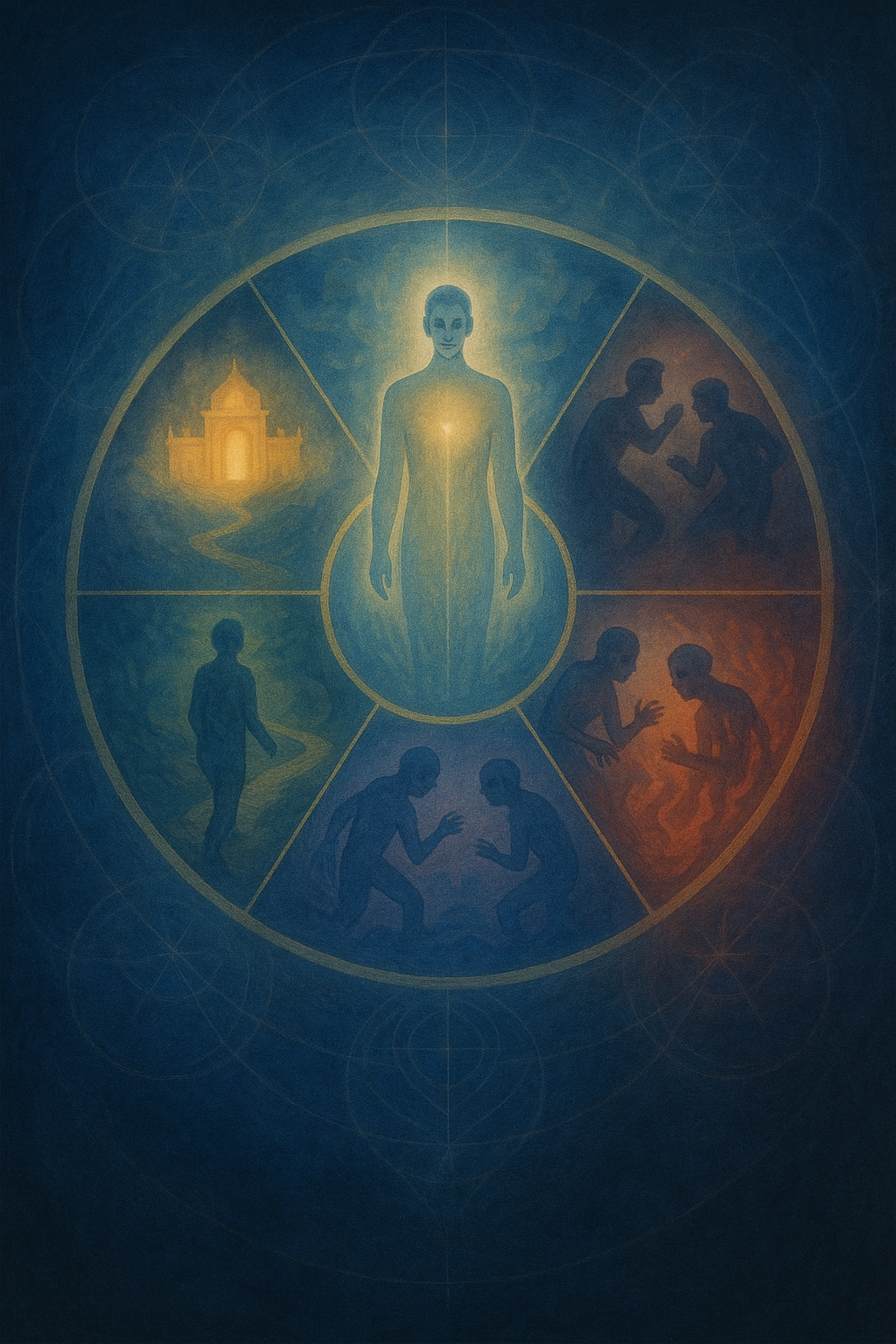
🗺️ Visual Map: The Cycle of Samsāra
Navigate the wheel of rebirth and its exit:
- God Realm (Deva): Blissful, yet proud. Can you release ego?
- Demigod Realm (Asura): Striving, jealous. Can you find peace?
- Human Realm: Balanced, awake. Can you cultivate wisdom?
- Animal Realm: Instinctive, fearful. Can you rise above?
- Hungry Ghost Realm: Craving, empty. Can you let go?
- Hell Realm: Tormented, hateful. Can you transform pain?
Beyond all six lies a hidden gate, Nirvāṇa: Unbound, radiant. Can you recognise the Clear Light?
This map mirrors your mind’s states, choose awareness to step off the wheel.
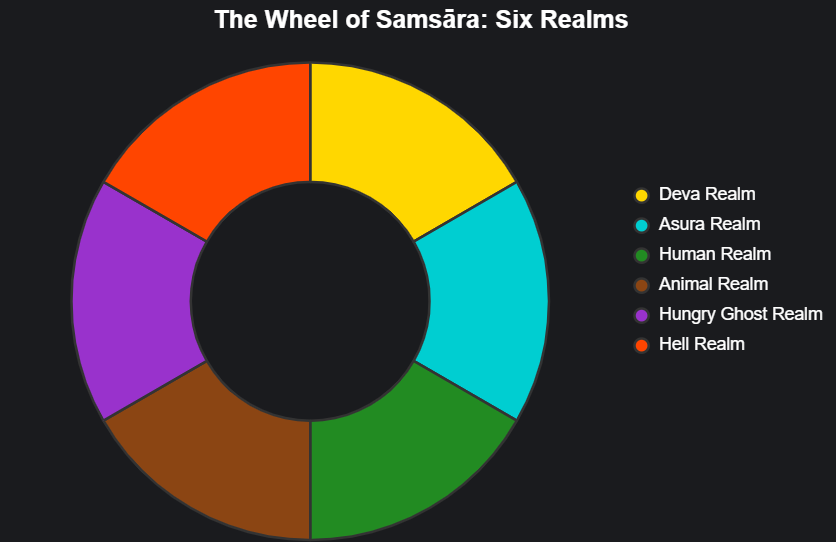
🔥 Chapter 7: The Middle Way is Fire
Na kāmānandaṃ anuyutto, na ca attakilamathānuyogi.
“Not addicted to indulgence, nor given to self-mortification.” The Buddha, on the Middle Way
After abandoning a life of princely luxury, the Buddha turned to extreme asceticism, fasting, silence, self-punishment. But he found no peace. His body collapsed. His mind frayed.
Then came the revelation: neither indulgence nor denial liberate the soul. Both are traps. The path lies in the middle, fierce in discipline, yet free from violence.
This is the Middle Way: a razor’s edge. It does not reject desire with hatred, nor embrace it with craving. It meets the fire without burning.
For the Gnostic, this teaching resonates as a method of gnosis-in-the-world: one must walk awake in a realm of illusion without falling for its temptations, nor fleeing into spiritual bypassing. The world must be met and seen through, not denied or decorated.
Balance is not softness, it is fire under control. Discipline with compassion. Awareness that does not flinch.
⚡ TL;DR The Middle Way
- The Middle Way avoids both sensual indulgence and extreme denial
- It is a path of balance, clarity, and disciplined awareness
- Desire is not evil, but must be understood, not obeyed
- Renunciation is not self-hatred, but self-liberation
- The Gnostic and Buddhist both walk the edge, seeing illusion, but not enslaved by it

💨 Chapter 8: The Gate of Death
Yathā pi pabbato selo, acalo suppatiṭṭhito;
Evaṃ mohakkhayā bhikkhu, pabbataṭṭhova santimā.
"Just as a mountain of rock, unshaken and firmly established,
so too a monk, with delusion destroyed, stands like a mountain, peaceful." Dhammapada 6:7
In Buddhist teaching, death is not the end. It is a moment of tremendous significance, a gateway where the illusions of solidity, self, and control dissolve.
At death, the body collapses, but the stream of consciousness does not vanish. It moves. It carries forward the imprints of karma, memories, tendencies, unfinished desires, into the space between lives.
This is the entry into the Bardo: the in-between state. A place of dreams, visions, revelations, and distortions, all shaped by the mind’s habits.
For the Gnostic, this threshold echoes the moment of the soul’s separation from the counterfeit body, a peeling away from the illusion of form to face the mirror of truth.
To die consciously is to pass through this gate with awareness. Not to escape fear, but to meet it without clinging.
⚡ TL;DR The Gate of Death
- Death is not the end but the beginning of a transitional state, the Bardo
- Consciousness continues after death, carrying karma and impressions
- The Bardo is shaped by the habits and fears of the mind
- Awareness at death allows one to pass through the gate without confusion
- Gnostic teaching echoes this: the soul must leave the illusion-body and remember its origin
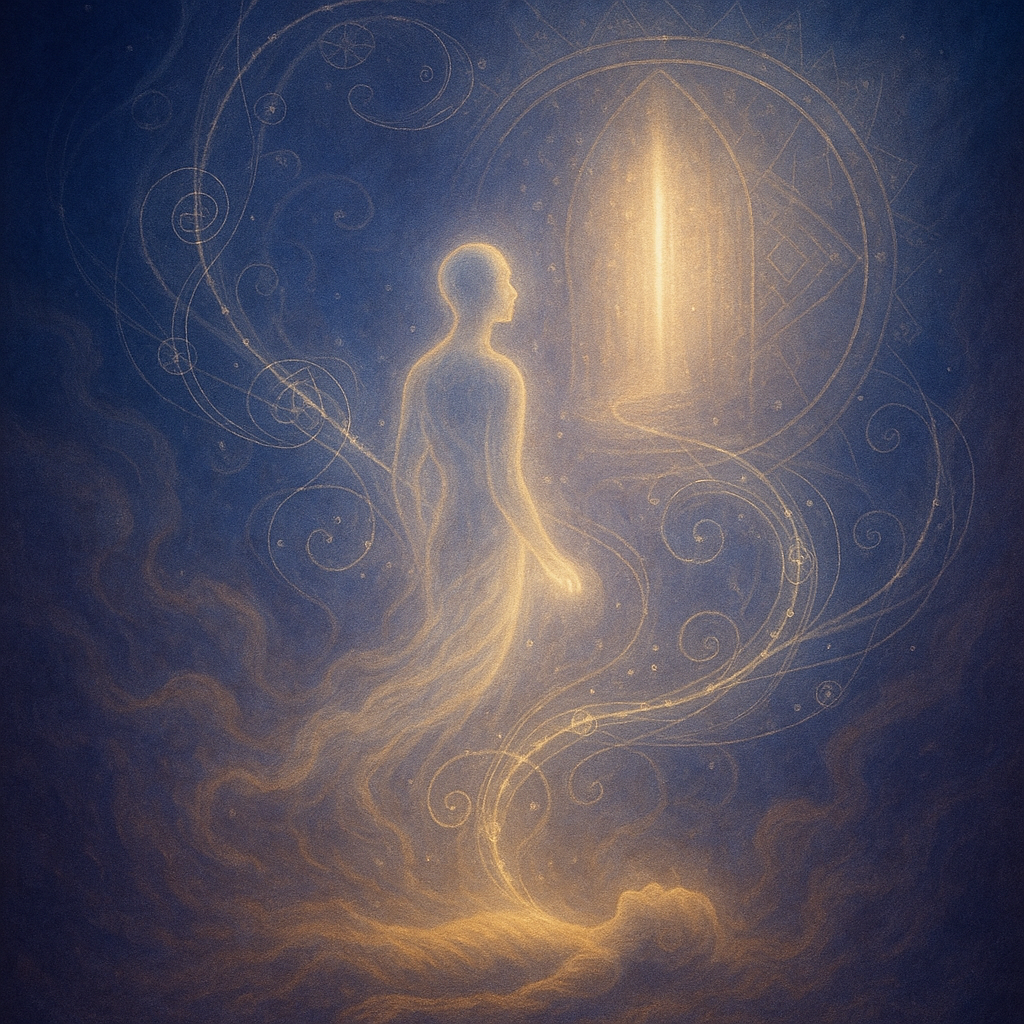
🪞 Chapter 9: The Mirror of the Mind
སེམས་ཀྱིས་དཔག་ཏུ་མེད་པའི་རྒྱུ་མཚན་སྐྱེད་པར་བྱེད་དོ།
“By the mind, it gives rise to innumerable causal phenomena.” Bardo Thodol (Tibetan Book of the Dead)
In the Bardo, there is no body, only mind. But the mind is not empty. It creates.
Everything repressed, ignored, denied, or craved begins to arise in dream-like form. Frightening visions. Beautiful illusions. Longing. Guilt. Bliss. Regret.
This is not punishment, it is reflection. The Bardo becomes a mirror of the mind, a psychic theatre where karmic imprints play out in full color.
If the soul panics, it grasps at these visions and falls into a new rebirth. If the soul remains calm and aware, it recognises these appearances as mind-made, and may transcend them.
Gnostic parallels are profound. The Archons project illusions to trap the soul. But those illusions have no power once seen for what they are: shadows of the self. The awakened mind does not fight the dream, it sees through it.
⚡ TL;DR The Mirror of the Mind
- The Bardo reflects the mind, every fear, desire, and action appears as vision
- These appearances are mind-made, not external judgements
- Clinging leads to rebirth; awareness opens the gate to liberation
- Gnostic echoes: illusion falls when the soul sees through the veil
- The soul’s task: remain clear and detached in the midst of projection
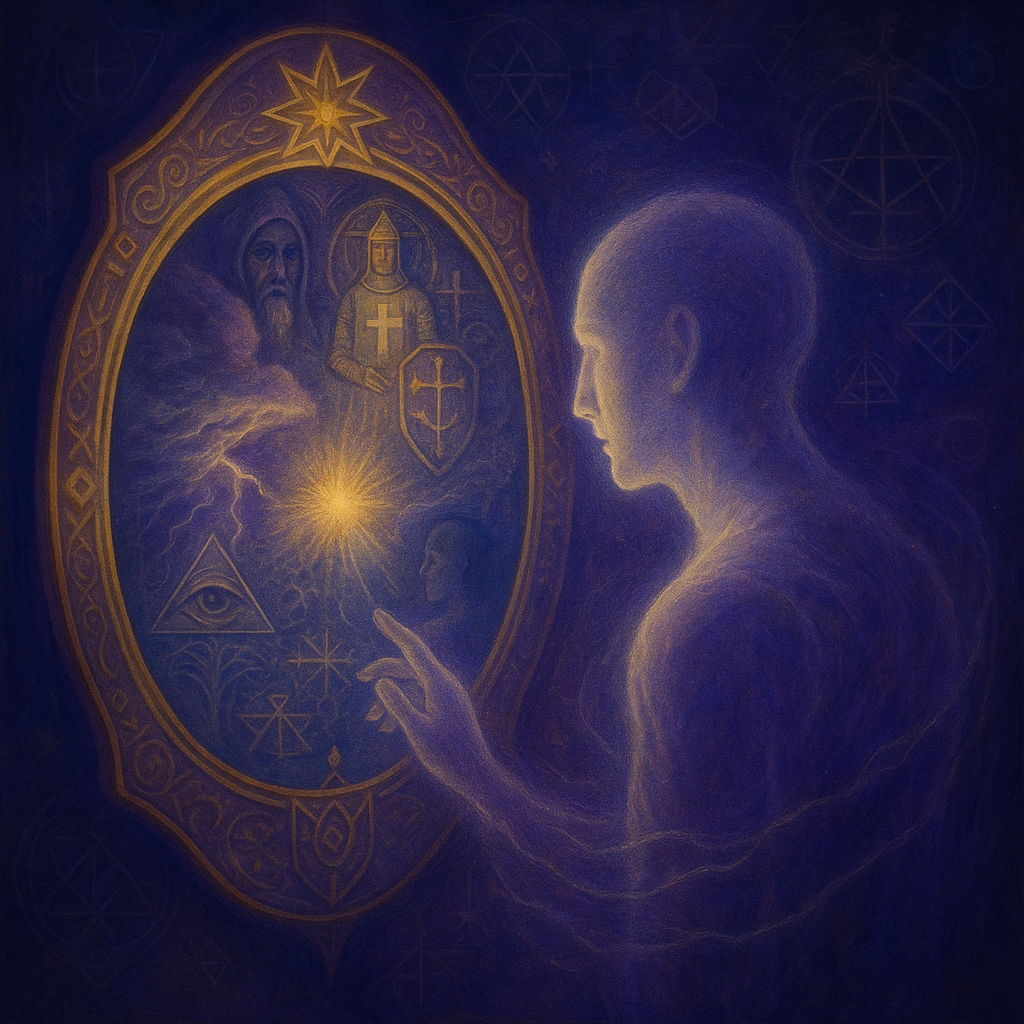
🌑 Chapter 10: The Lords of Light and Shadow
ཞལ་གྱི་འོད་དམར་ནི་གདུགས་སྣང་རྫུན་པའི་སྣང་བ་ཡིན།
“The red light of [zhal] is an intense/overwhelming illusory appearance.” Bardo Thodol (Tibetan Book of the Dead)
On the second week in the Bardo, figures of dazzling light and terrible form begin to appear.
Some radiate compassion and peace, these are the peaceful deities. Others roar in flame and shadow, these are the wrathful deities. Both are aspects of the same truth.
They are not gods in the Western sense. They are projections of the soul’s mind, infused with karmic charge. If one meets them with terror or desire, the soul recoils, and spirals into rebirth. But if one sees through the projection, the deity becomes a portal of release.
To the Gnostic, these figures echo the Archons and Aeons, symbolic powers that appear to the soul at threshold moments. The Archons seek to bind; the Aeons to awaken. But both are masks. Only the unconditioned spark beneath them is real.
All forms in the Bardo, light or shadow, are dreams. Recognition, not worship or resistance, is the way through.
⚡ TL;DR The Lords of Light and Shadow
- Peaceful and wrathful deities arise in the Bardo as aspects of the soul’s karma
- They are not separate beings, but projections of mind infused with symbolic meaning
- Terror or craving binds the soul; recognition leads to freedom
- Gnostic resonance: these figures parallel Archons (binders) and Aeons (liberators)
- All forms are illusory, to see clearly is to step through the veil
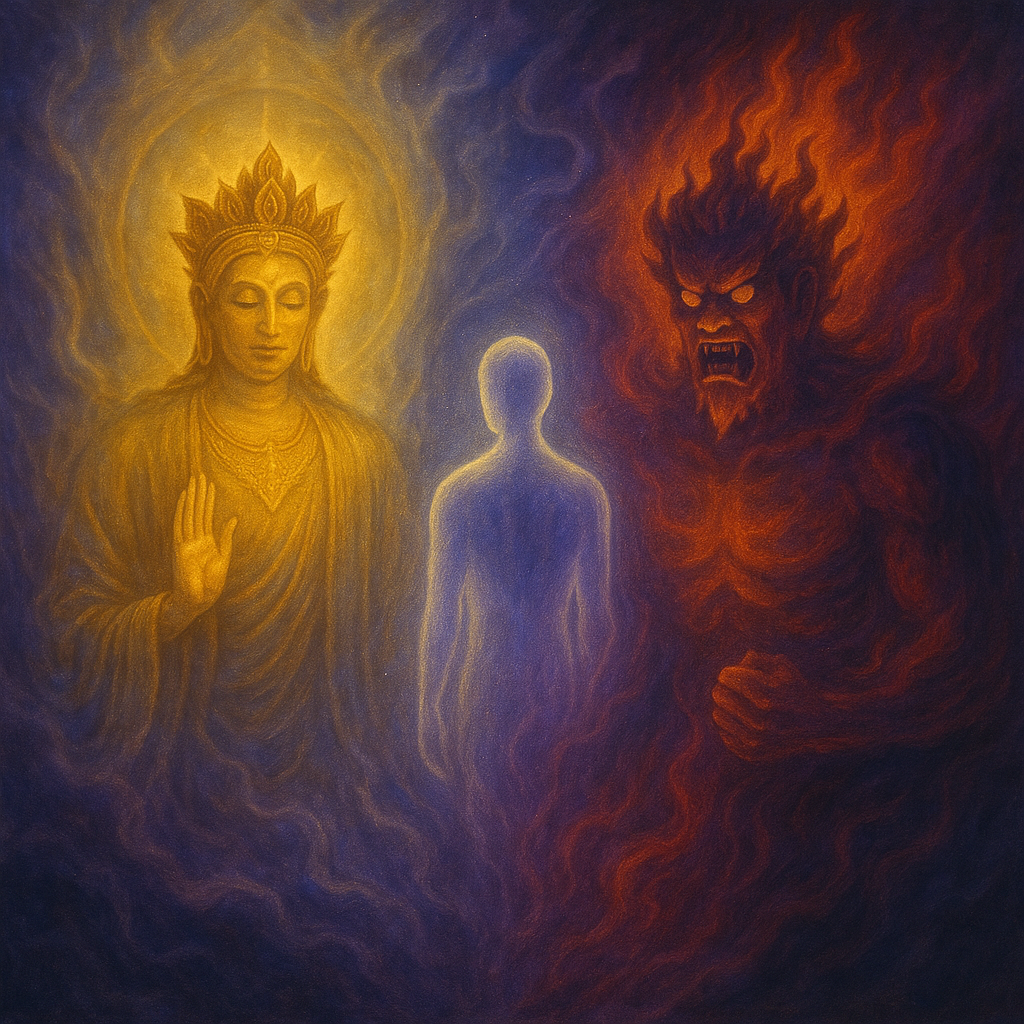
🌘 Chapter 11: The judgement Is You
“Attanā va kataṃ pāpaṃ, attanā saṃkilissati.”
“By oneself is evil done; by oneself is one defiled.” Dhammapada, Verse 165
There is no judge in the Bardo. No heavenly court. No cosmic scale. Only reflection.
Consciousness sees the echoes of every deed, word, and thought, not as punishment, but as vibration.
Everything unresolved rises. Everything clung to clings back.
This moment has been called “the weighing of the heart.” But it is not your heart being weighed. It is you, weighing your own soul.
For the Gnostic, this is the encounter with the mirror of Sophia, where false selves burn away, and only what is real remains. The Archons may have asked questions. But now, you are both question and answer.
If the Consciousness cannot look upon its own karma without fear, it recoils. And the wheel turns again.
⚡ TL;DR The judgement Is You
- There is no external judge in the Bardo, only the soul facing its own reflection
- Unresolved karma appears not as punishment, but as echo and form
- The soul’s ability to meet itself without fear determines the outcome
- Gnostic parallel: Sophia’s mirror, the revelation of truth beneath illusion
- This is the pivot: acceptance liberates; resistance reincarnates
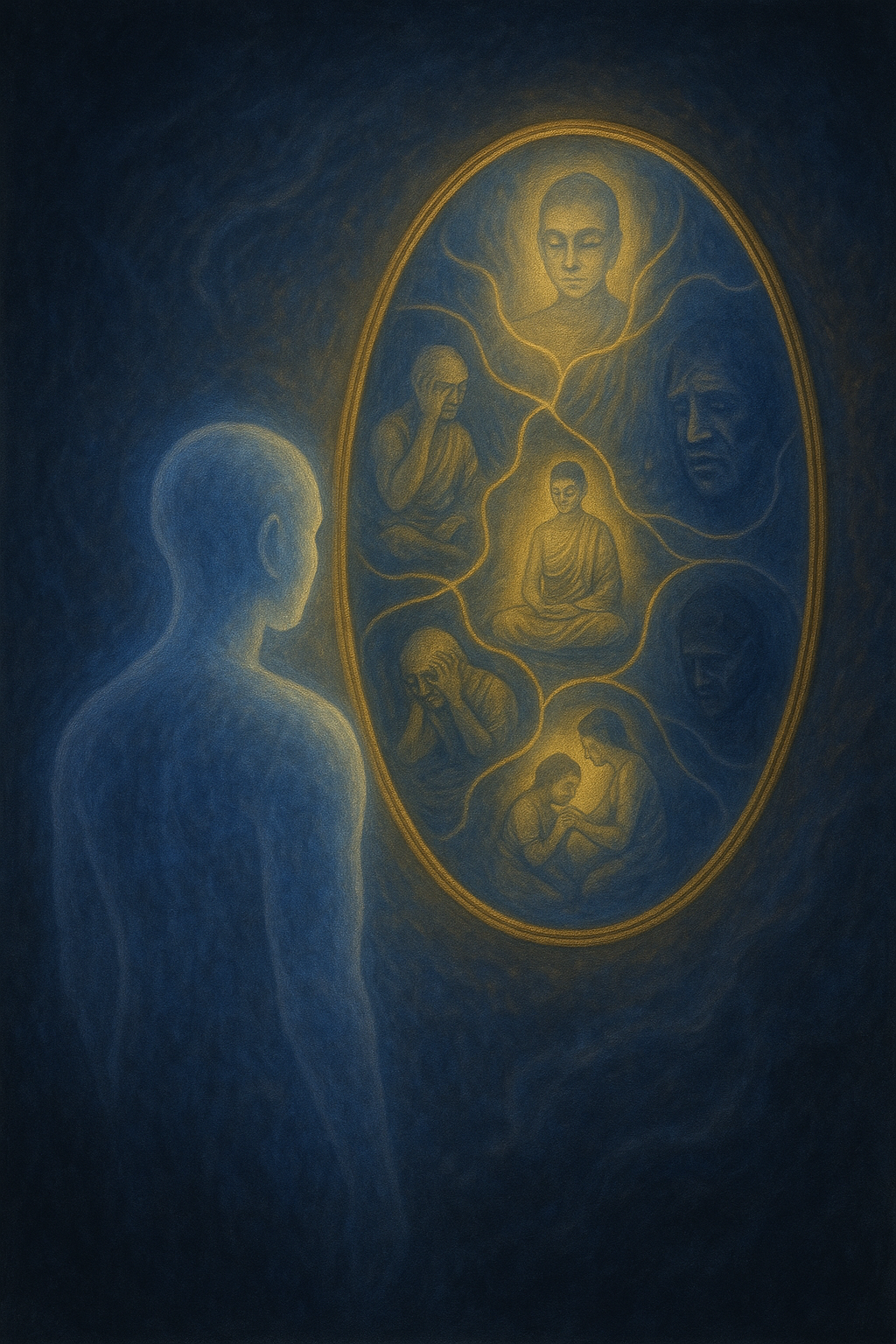
🌕 Chapter 12: The Clear Light
འོད་གསལ་དང་རང་རིག་གཉིས་མེད་ཡིན།
“The Clear Light and innate awareness are not two.” Tibetan Book of the Dead
In the deepest silence of the Bardo, all forms fall away.
No more deities. No more mirrors. No more fear. Only radiance, unbounded, silent, infinite.
This is the Clear Light. It is not a tunnel. Not a god. It is your original awareness, before thought and form.
To recognise it is liberation. To recoil from it is rebirth.
Most beings turn away. The Light is too vast, too formless, too pure. The ego clings to story. To shape. To sensation. And so, the wheel turns again.
But the awakened one does not fear the Light. They become it.
For the Gnostic, this is the moment the divine spark remembers itself,not as a self, but as the Light behind all selves.
⚡ TL;DR The Clear Light
- The Clear Light is the soul’s original, unconditioned awareness
- It appears after death as pure radiance, formless, infinite, silent
- To recognise it without fear is liberation (nirvāṇa)
- Most recoil, clinging to form, and are reborn
- Gnostically, it is the divine spark awakening beyond illusion
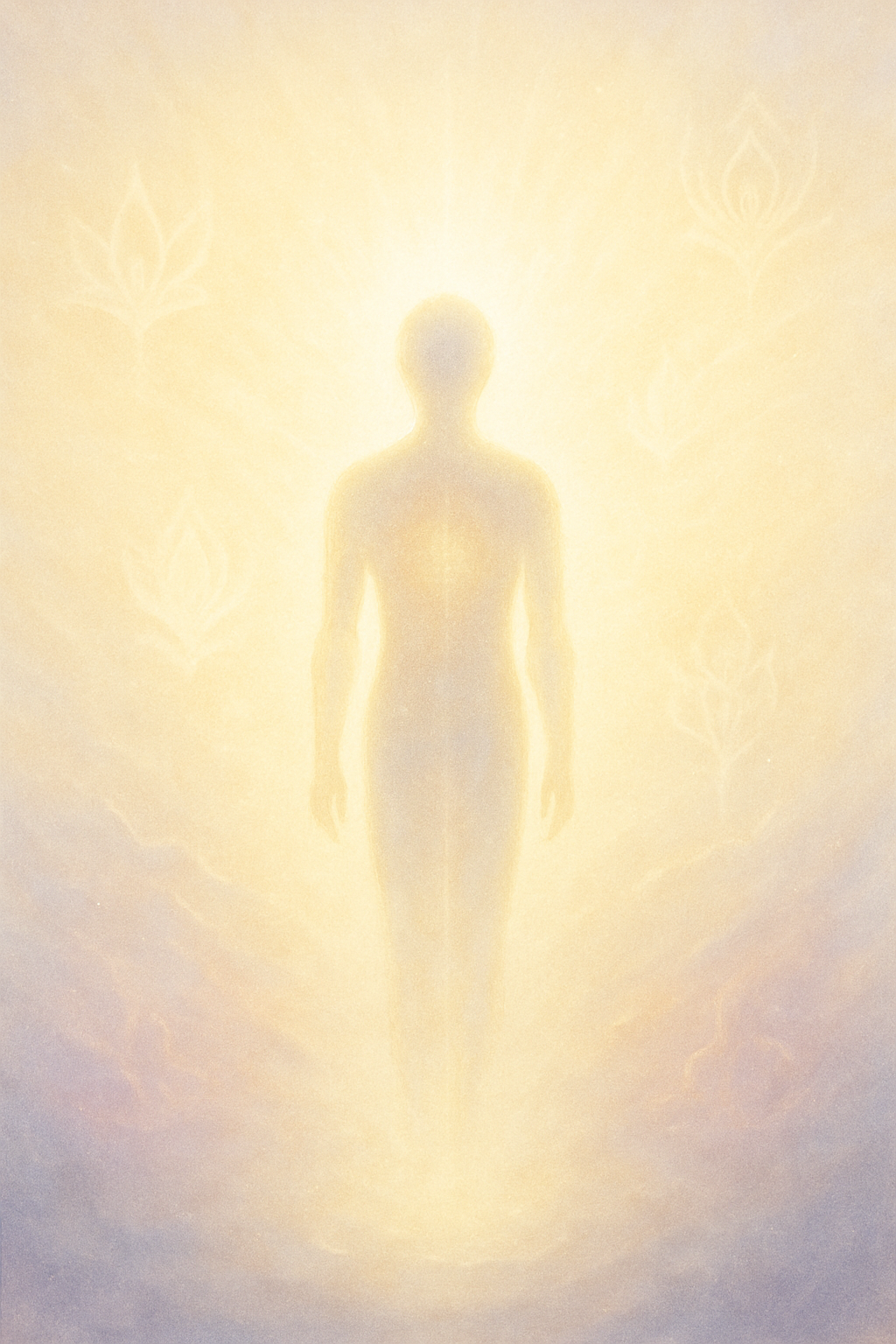
🧠 Scroll I Quiz: How Deep Was Your Descent?
1. What is the root cause of samsāra according to Buddhism?
Correct! Samsāra is driven by avijjā (ignorance) and taṇhā (craving).
2. Which of these is not one of the six realms of rebirth?
Correct! While shadow realms exist in other systems, they're not part of the classic six in Buddhist cosmology.
3. What is the purpose of the Bardo teachings?
Correct. The Bardo texts aim to guide consciousness through death’s liminal stages and recognise the Clear Light.
4. Reflective: Have you ever experienced a moment of stillness that felt timeless? What might that have been, illusion or Clear Light?
Insight: Recognizing the Clear Light even for a moment is the beginning of liberation.
5. In Gnostic terms, what do the “Lords of Light and Shadow” symbolize?
Correct. These figures test the soul’s discernment, appearing in archetypal or karmic form.
6. What is the Clear Light in Buddhist death teachings?
Correct. The Clear Light is your true nature, radiant, formless awareness. Recognizing it ends the cycle.
7. Which element of the Bardo best matches the Gnostic concept of the Archons?
Correct. Just as Archons deceive the soul with illusion, the wrathful and fearful projections in the Bardo arise from unresolved karma and misidentification.
8. Reflective: If the Clear Light appeared to you today, would you recognise it, or would fear make you look away?
Insight: Recognition requires preparation. Each moment of clarity brings you closer.
📖 Glossary
- Aeons
- Emanations of divine consciousness; forces of liberation and awakening.
- Anattā
- Non-self; the insight that there is no fixed, eternal “I.”
- Anicca
- Impermanence; the ever-changing nature of all phenomena.
- Archons
- Rulers or gatekeepers of the lower worlds who bind the soul to illusion.
- Bardo
- The intermediate state between death and rebirth in Tibetan Buddhism.
- Chikhai, Chönyi, Sidpa Bardo
- The three main stages of the Bardo: moment of death, visionary state, and transition into rebirth.
- Clear Light
- The radiant awareness that appears after death; recognition of it brings liberation.
- Divine Spark
- The innermost fragment of true divinity within the soul, trapped in matter.
- Dukkha
- Suffering or dissatisfaction; the inescapable tension of conditioned life.
- Karma
- Intentional action, shaping both present and future conditions.
- Nirvāṇa
- Liberation; the unconditioned peace beyond craving and becoming.
- Ösel
- Tibetan term for the Clear Light of primordial awareness.
- Peaceful & Wrathful Deities
- Projections of the mind encountered in the Bardo; they represent wisdom and karmic energy.
- Samsāra
- The endless cycle of birth, death, and rebirth across six realms.
- Sophia
- The Gnostic embodiment of wisdom who falls and seeks redemption through the awakening of humanity.
- Taṇhā
- Craving or thirst; the force that perpetuates rebirth.
- Twelve Nidānas
- The twelve-linked chain of dependent origination explaining the process of samsāric rebirth.
🗣️ Reflection Prompt: Did You Glimpse the Light?
“If you were to meet your own mind without form, fear, or story, would you recognise it?”
After journeying through the Bardo, the Clear Light, and the illusions of self, we now ask:
- Have you ever known a moment where the mind was utterly still?
- Do you fear ego dissolution — or do you long for it?
- What does ‘awakening’ mean to you now, after this scroll?
Write your reflection in your journal or share it with the temple of seekers:
✨ The Scroll Unfolds
Scroll I has carried you through the realms of Samsāra, the karmic web, and the radiant terror of truth. In Scroll II, we descend deeper into awakening through fire: wrathful compassion, bodhisattva vows, and the shattering of illusion.
🔥 Scroll II: The Flame of Awakening The Bodhisattva’s Vow, the Fire of Compassion, and the Wisdom Beyond Self
⚠️ Buddhist Diversity Disclaimer
This scroll draws primarily from Mahāyāna and Vajrayāna traditions, especially the bodhisattva path, śūnyatā, and compassionate action. Interpretations vary across lineages. Theravāda emphasises self-effort and anattā, while Pure Land traditions invoke devotional surrender. This is one fire-lit thread, not the entire Dharma flame.
Previously: You passed through the Bardo, saw the wheel of becoming, and glimpsed the Clear Light. Now the flame ignites, this scroll descends into compassion’s fire, the bodhisattva vow, and the fierce path of awakening.
🌸 Chapter 13: The Wheel of Birth and Death
Anikkhanto 'haṁ saṁsāraṁ, sandhāvissaṁ anibbisaṁ;
Gahakāraṁ gavesanto, dukkhā jāti punappunaṁ.
“In countless births I have run, seeking the builder of this house. Painful is birth again and again.” The Dhammapada
In Buddhist cosmology, life is not a single thread but a vast wheel, saṃsāra, the endless cycle of birth, death, and rebirth. Each turn conditioned by karma, each return shaped by craving and ignorance.
The soul, or rather, the stream of consciousness, clings to form, sensation, becoming. What is reborn is not a fixed “self,” but a flow of conditioned tendencies, endlessly chasing fulfillment, endlessly circling back.
Why does the wheel spin? Because the mind grasps. Because desire burns. Because ignorance veils the path beyond.
The Buddha’s teaching is not to escape life, but to end the compulsion to repeat it. To step off the wheel by seeing clearly, acting purely, and loosening the fetters that bind us to return.
“The house-builder you have been seen! You shall build no house again. All your rafters are broken; the ridgepole is shattered. The mind has attained the unconditioned.”
The Dhammapada
⚡ TL;DR The Wheel of Birth and Death
- Saṃsāra; the endless cycle of birth, death, and rebirth shaped by karma.
- There is no fixed soul; only a conditioned stream of consciousness and tendencies.
- The wheel turns because of craving (taṇhā) and ignorance (avijjā).
- The Buddha’s path teaches how to break the cycle and reach liberation (nibbāna).
- Escaping saṃsāra is not death, it is freedom from conditioned becoming.
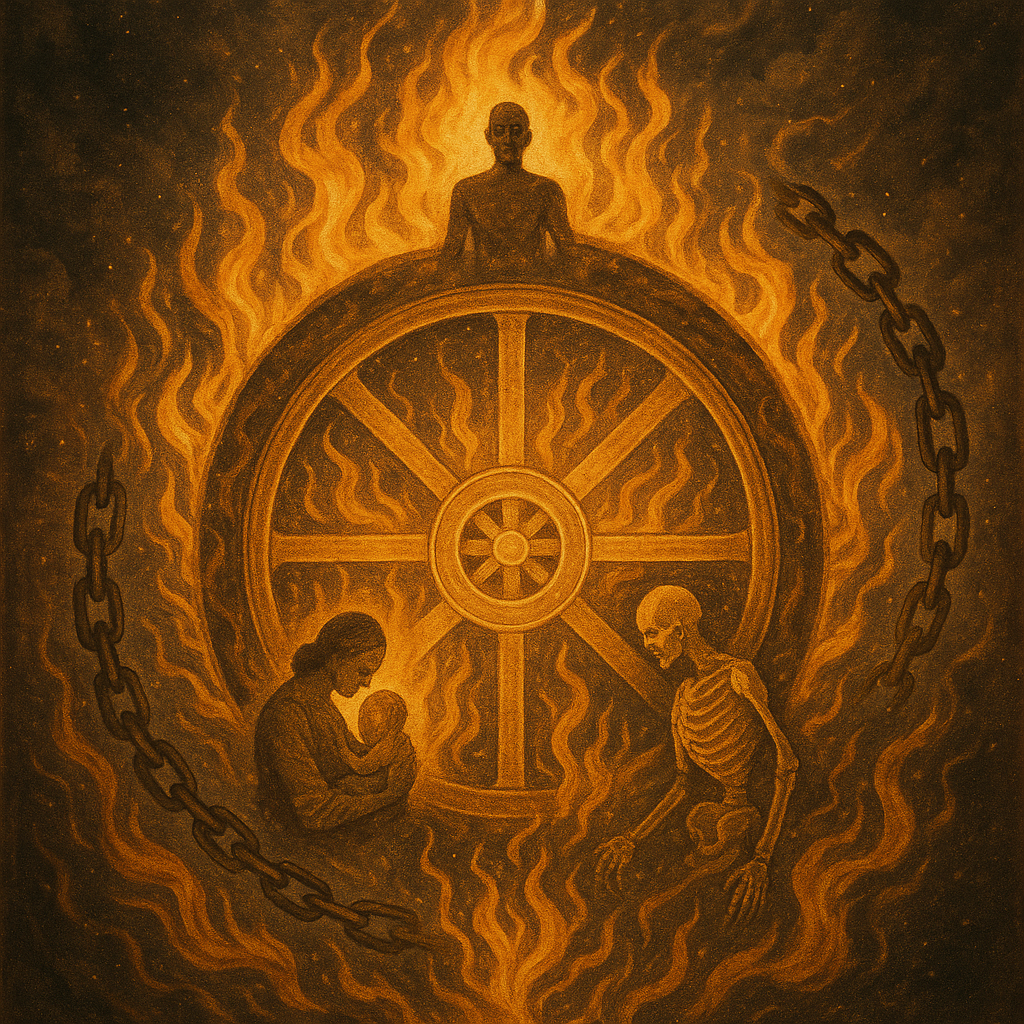
🌊 Chapter 14: Karma: The Seeds We Sow
Sabbe sattā kammassakā, kammadāyādā, kammayonī, kammabandhū, kammapaṭisaraṇā.
“All beings are owners of their deeds, heirs of their deeds, born of their deeds, related to their deeds, supported by their deeds.” The Anguttara Nikāya
In Buddhist thought, karma is not reward or punishment, it is cause and effect.
Every thought, word, and action plants a seed. These seeds ripen over time, shaping the conditions of future experience. No god assigns fate; no external judge hands down decrees. We walk inside the garden we ourselves have sown.
Crucially, karma is not fate. It is conditioned becoming. Old seeds shape the soil, but new choices can change the harvest.
This is why the Buddha taught: act with awareness. Cultivate good roots: compassion, patience, wisdom. Weed out harmful roots: anger, greed, delusion.
The chain of cause is unbroken, but at every link, there is choice.
“If you want to know your past, look at your present condition. If you want to know your future, look at your present actions.”
Buddhist proverb
⚡ TL;DR Karma: The Seeds We Sow
- Karma is cause and effect, the shaping of future conditions by present actions.
- It is not fate or punishment, but a natural law of causality.
- Old karma influences, but does not lock, the future, new actions matter.
- The Buddha’s path encourages mindful planting: sowing wisdom, compassion, and awareness.
- Each moment offers a chance to break old cycles and choose new seeds.
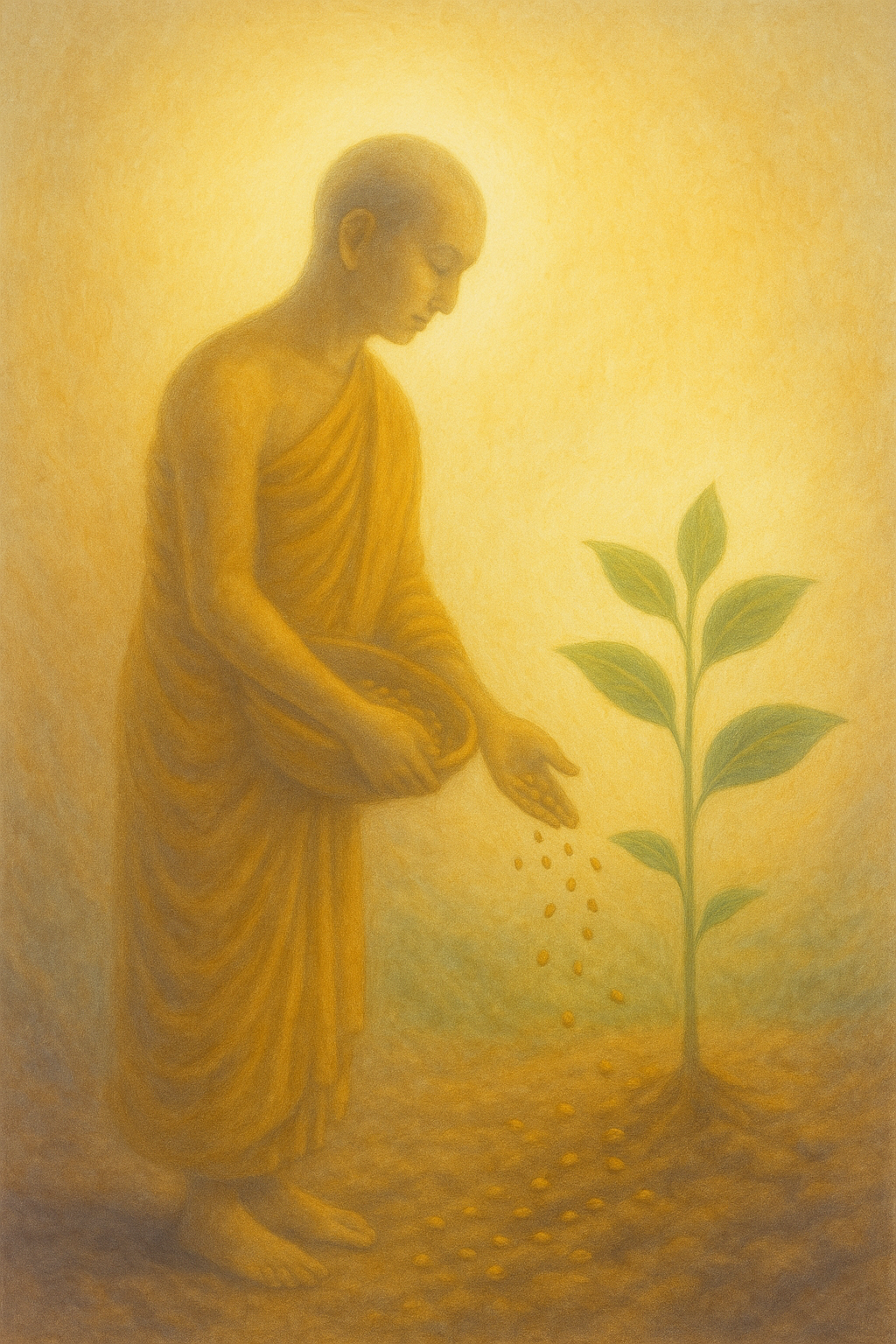
🌠 Chapter 15: Rebirth: The Wheel Turns
Na taṁ mātā pitā kayirā, aññe vā pi ca ñātakā; Sammāpaṇihitaṁ cittaṁ, seyyaso naṁ tato kare.
“Neither mother, nor father, nor any other relative can do one greater good than one’s own well-directed mind.” The Dhammapada
In Buddhist cosmology, rebirth is not about a soul jumping body to body, it is the continuation of process.
When conditions are right, consciousness arises again. When old karma ripens, it shapes the next becoming.
This is saṃsāra: the wheel of birth and death, spun by craving, ignorance, and clinging.
The wheel turns through six realms, gods, titans, humans, animals, hungry ghosts, hell beings, but all are impermanent. All are marked by dukkha: unsatisfactoriness.
Rebirth is not destiny, but inertia. To break free, the Buddha taught, one must break the inner chains: craving, aversion, delusion.
With insight and practice, the wheel can stop turning.
“Through many births I wandered on, seeking the builder of this house. Painful is birth again and again. But now, house-builder, you are seen! You shall not build this house again.”
The Dhammapada
⚡ TL;DR Rebirth: The Wheel Turns
- Rebirth is the continuation of conditioned consciousness, shaped by karma.
- It is not a permanent self, but a process of becoming.
- The wheel of saṃsāra turns through six realms, all marked by impermanence and suffering.
- Insight into craving and clinging is the key to liberation.
- When ignorance ends, the wheel stops turning, and freedom dawns.
Anattā (no-self) distinguishes Buddhist rebirth: no eternal soul migrates, only a stream of consciousness shaped by karma, like a flame passing from candle to candle.
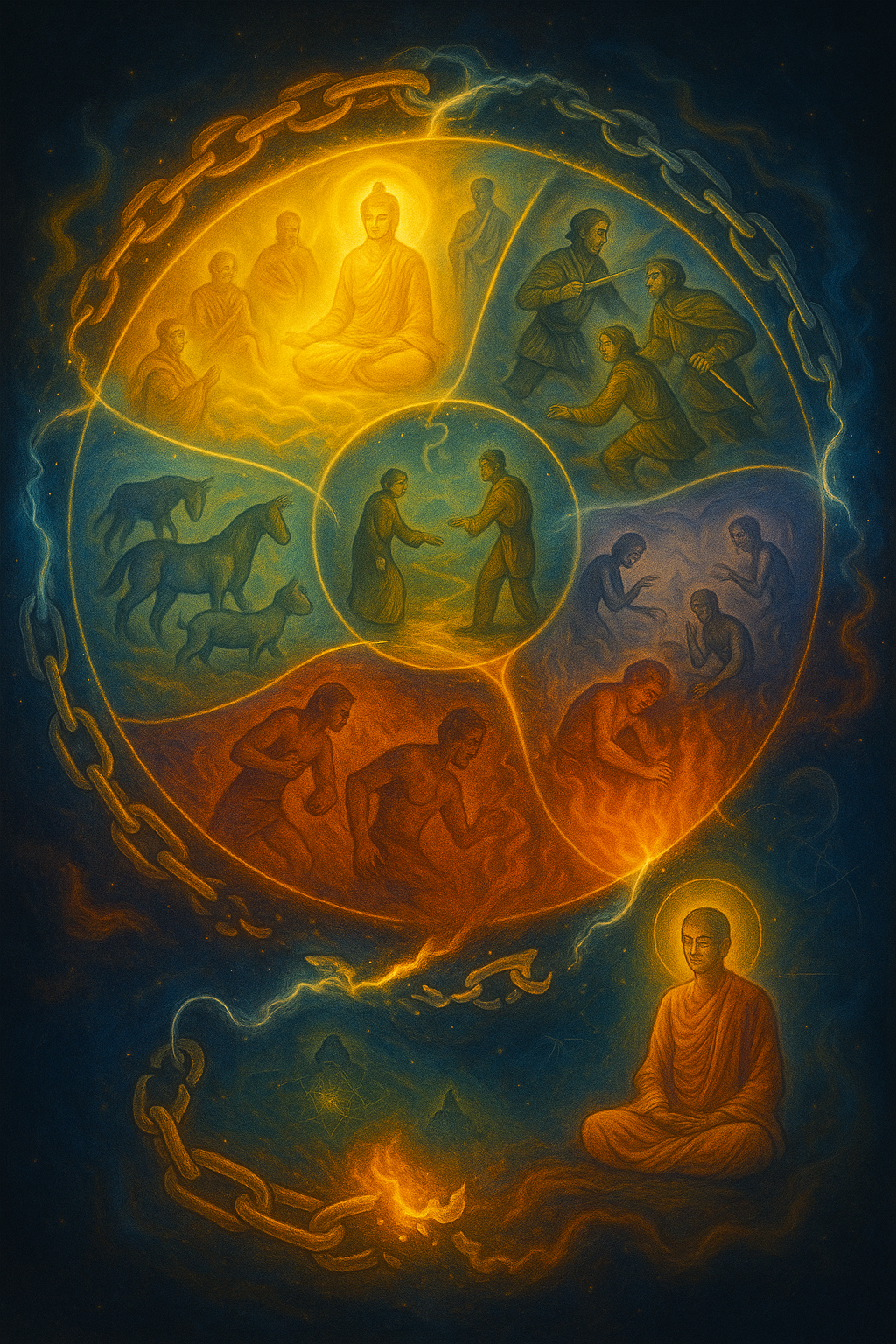
🌌 Chapter 16: Karma: The Law of Cause & Effect
Sabbe sattā kammassakā, kammadāyādā, kammayonī, kammabandhū, kammapaṭisaraṇā.
“All beings are owners of their karma, heirs to their karma, born of their karma, related to their karma, abide supported by their karma.” The Buddha, Anguttara Nikāya
Karma is often misunderstood.
It is not cosmic punishment or reward. It is not a divine ledger keeping score.
Karma means action, intentional action, shaped by mind. Every thought, word, and deed leaves an imprint, ike ripples on a vast sea.
These ripples combine, amplify, collide, shaping not just the future, but the shape of the one who acts.
The Buddha taught: “What you are is what you have done. What you will be is what you do now.”
There is no fixed self, but there is momentum. Karma is the great sculptor, and mind is the chisel.
“With our thoughts, we make the world.”
The Dhammapada
⚡ TL;DR Karma: The Law of Cause & Effect
- Karma is intentional action, mental, verbal, physical.
- Every act leaves a trace, shaping future experiences and conditions.
- Karma is not fate or judgement, it is natural cause and effect.
- Good and bad karma condition future rebirths and mind states.
- Freedom begins by seeing karma clearly and acting with wisdom.
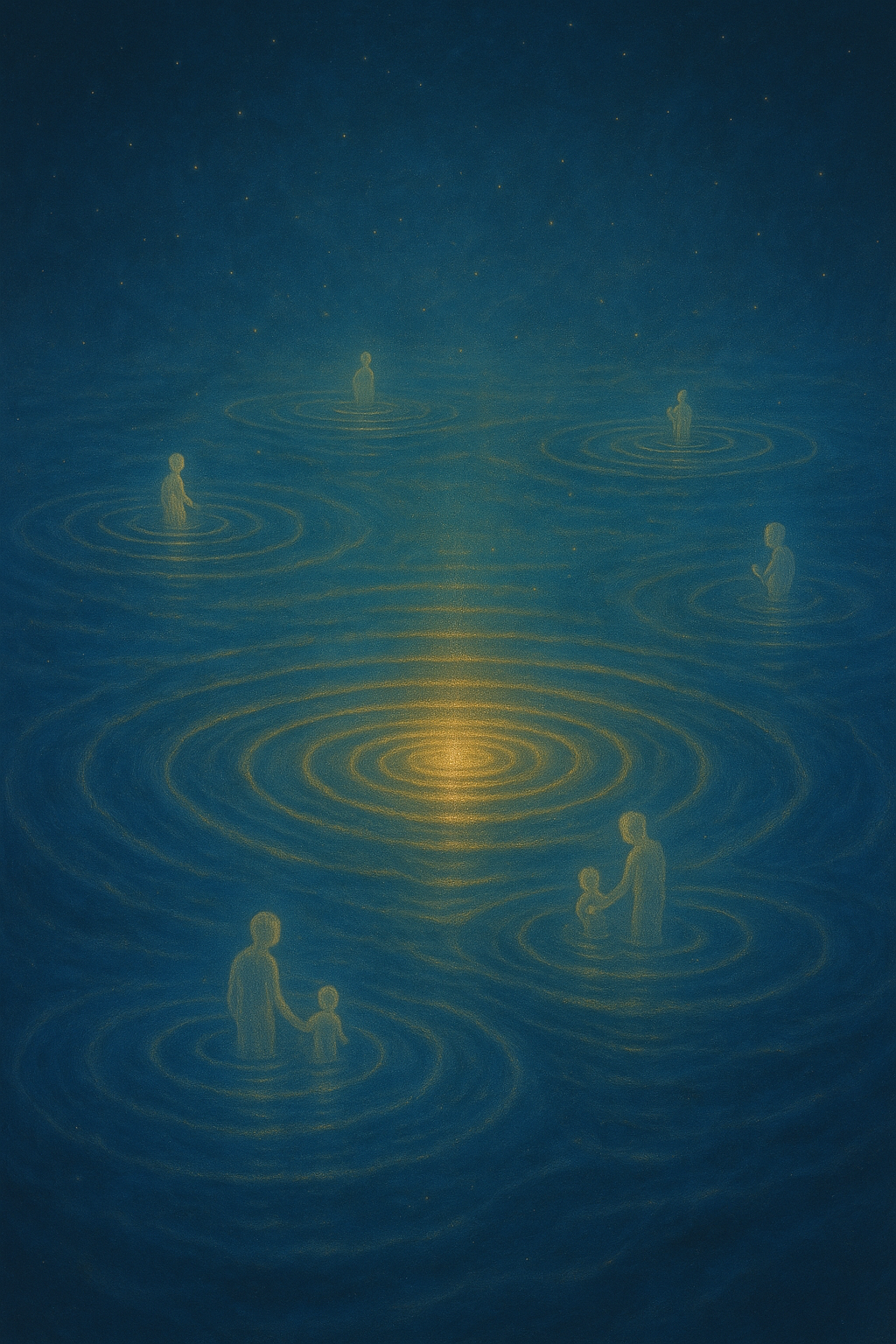
🌊 Chapter 17: Samsāra: The Endless Wheel
“Long have you wandered through birth and death, like a traveler lost in the desert, forgetting the way home.”
The Buddha, Saṁyutta Nikāya
Samsāra is the great wheel, the endless cycle of birth, death, and rebirth. It is not a place, but a process.
Beings circle endlessly through worlds and forms, driven by karma, grasping, fearing, clinging, and forgetting.
The human realm, the heavenly realms, the lower realms all are temporary stations, spun by ignorance and desire.
Samsāra is not punishment. It is inertia. The rolling momentum of unawakened mind.
Each rebirth offers new chances, but each is also bound by the same blind turning.
“Not until the root of craving is cut does the wheel come to rest.”
The Dhammapada
⚡ TL;DR Samsāra: The Endless Wheel
- Samsāra is the cycle of birth, death, and rebirth driven by karma and craving.
- It spans many realms, human, divine, animal, ghostly, hellish, none permanent.
- Ignorance, craving, and clinging keep the wheel spinning.
- The goal is not to “win” samsāra, but to transcend it through wisdom and release.
- Nirvāṇa is the end of samsāra, the stilling of the wheel.
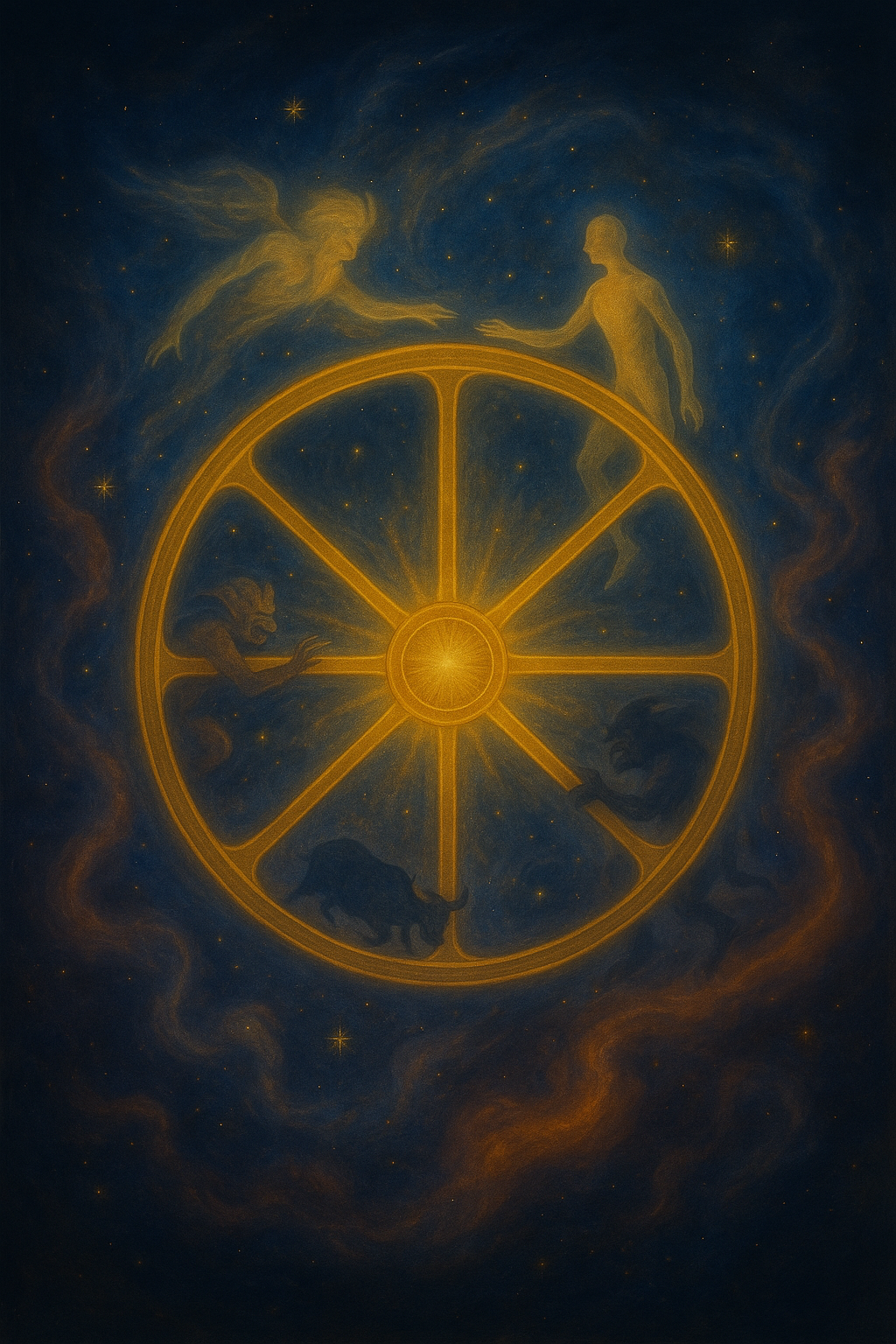
🪷 Chapter 18: Karma The Seed and the Fruit
Sabbe sattā kammassakā, kammadāyādā, kammayonī, kammabandhū, kammapaṭisaraṇā.
“All beings are owners of their deeds, heirs of their deeds, born of their deeds, related through their deeds, and abide supported by their deeds.” The Buddha, Anguttara Nikāya
Karma is not punishment. It is not cosmic revenge. It is cause and effect.
Every intention, every act, every thought plants a seed. That seed bears fruit, in this life or the next.
Good actions ripen as peace, connection, clarity. Harmful actions ripen as suffering, confusion, loss.
Karma shapes samsāra, but it does not trap you. Because intention now reshapes the flow.
“Even a single drop of water, if consistently falling, can wear through stone.”
Buddhist Proverb
Every moment is a seed. Every breath is a chance to shift the future.
⚡ TL;DR Karma: The Seed and the Fruit
- Karma means intentional action, mental, verbal, or physical, that shapes future experience.
- Karma operates on the principle of cause and effect, not reward or punishment.
- Positive karma ripens as joy and clarity; negative karma ripens as pain and confusion.
- Karma binds us to samsāra, but right intention and wisdom can transform it.
- Every action now matters, each is a seed shaping the path ahead.
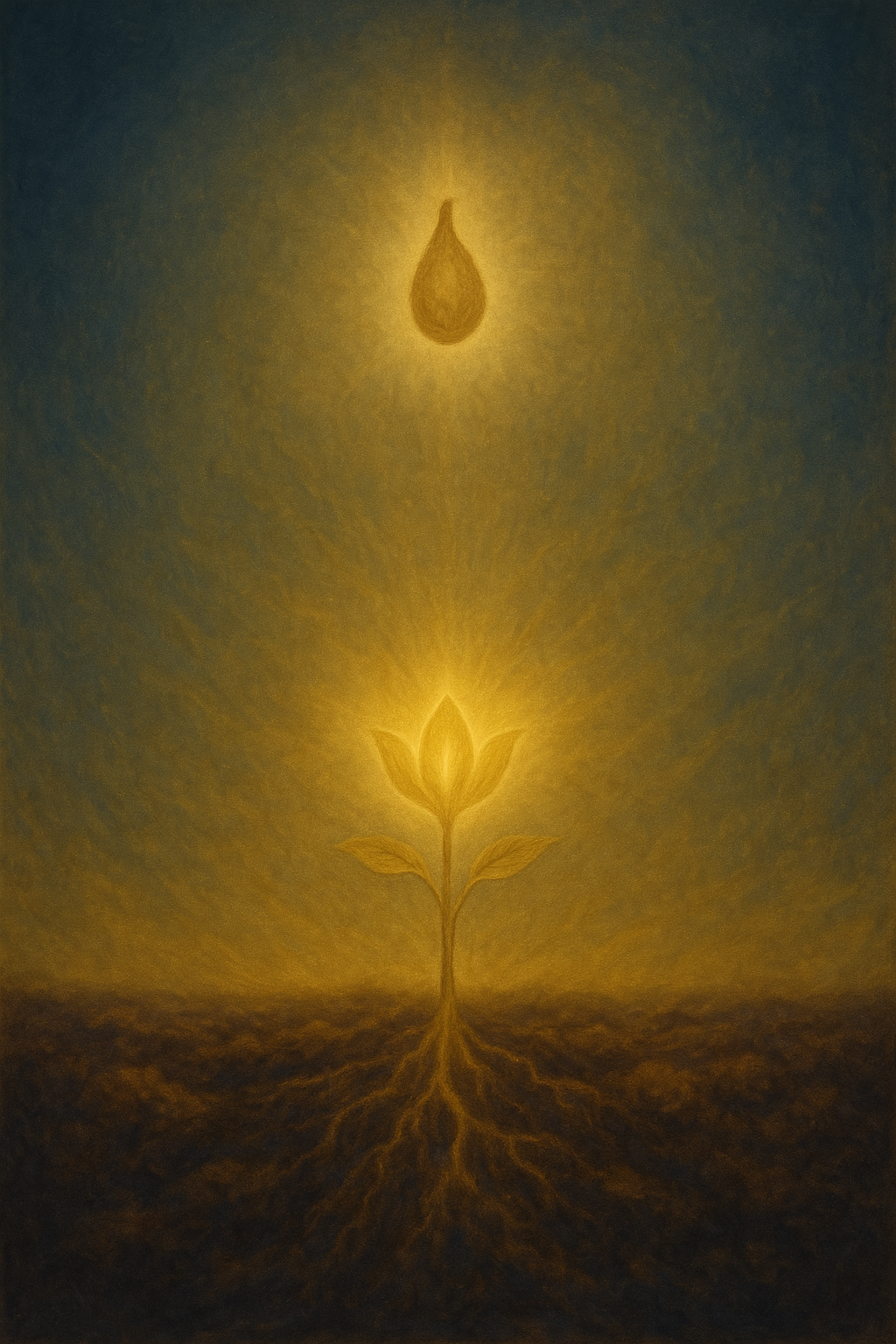
🌊 Chapter 19: The Ocean of Samsāra
Dīghā jāti saṁsāraṁ, aññāṇaṁ arahato gatiṁ.
“Long is the cycle of birth and death for the fool who does not know the true path.” Dhammapada
Samsāra is the endless ocean of birth, death, and rebirth. It is the wheel that spins not because of fate, but because of clinging.
We cling to identity, to pleasure, to permanence, to self. And so we return, lifetime after lifetime, chasing the mirage.
The Buddha did not call this world evil, but he called it unsatisfactory (dukkha): a sea of constant change, where every wave rises and falls, never fully graspable.
“Not until the ocean is emptied, not until the mountains are ground to dust, will craving find satisfaction.”
Buddhist Teaching
Samsāra cannot be escaped by running. It is escaped by awakening.
⚡ TL;DR The Ocean of Samsāra
- Samsāra is the cycle of birth, death, and rebirth, driven by craving and ignorance.
- It is not a punishment, but a pattern of clinging and becoming.
- The world is impermanent and unsatisfactory; chasing satisfaction only deepens the cycle.
- True escape comes through wisdom and non-attachment, not through external change.
- To cross samsāra is to wake up, not run away.
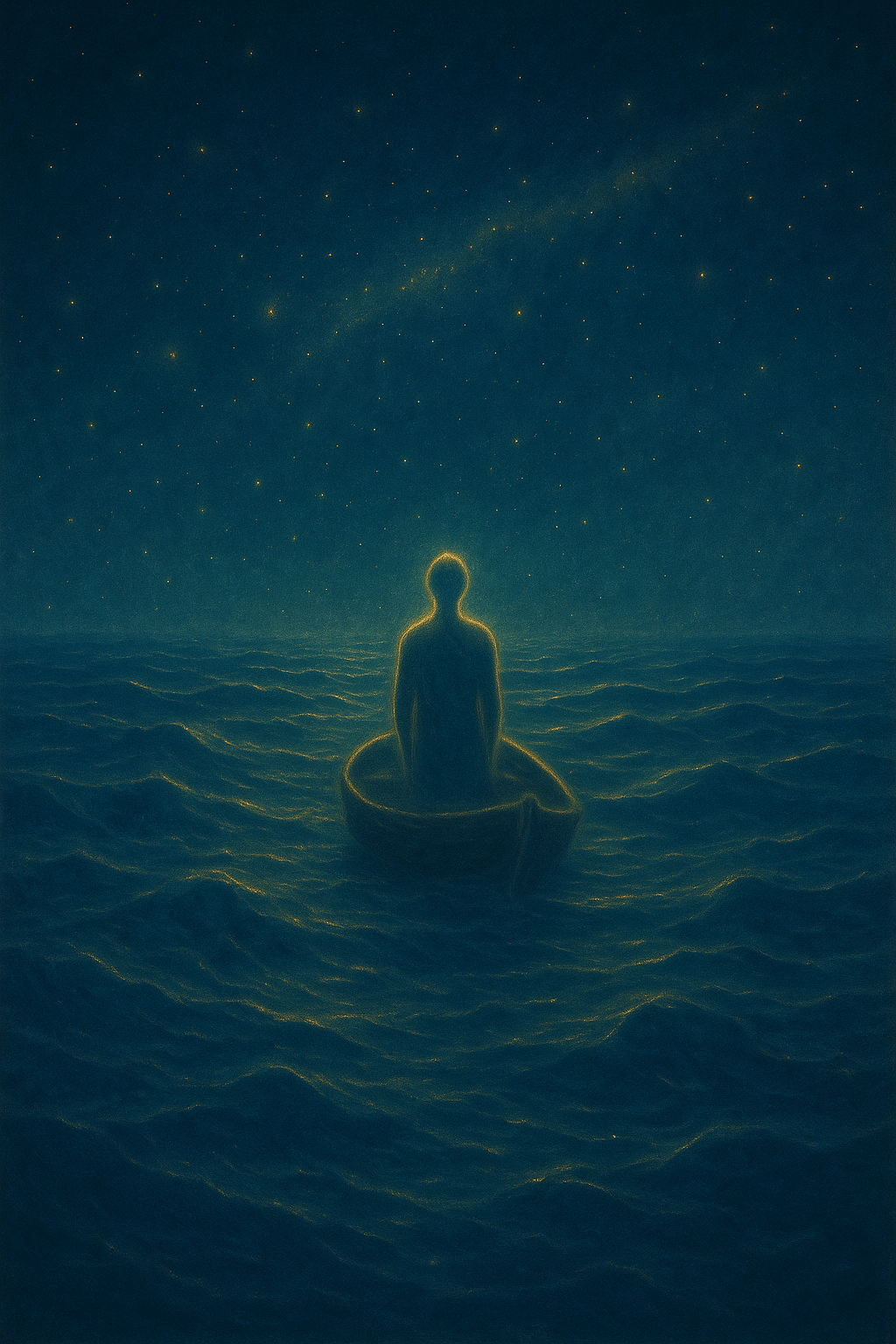
🌸 Chapter 20: The Dharma Gate of Liberation
धर्मद्वार
“The Dharma gate is boundless; I vow to enter it.” Zen Buddhist vow
The Buddhist afterlife is not just a passage, it is a teaching ground.
Every bardo, every rebirth, every encounter with suffering is a Dharma gate, a threshold through which the soul can awaken.
But these gates do not open automatically. They require presence, intention, and clear seeing.
The awakened practitioner learns to pass through these gates while alive: in every moment of fear, attachment, or confusion,they ask, What is this showing me? What is the Dharma here?
“When you meet the Buddha, kill the Buddha. When you meet the patriarchs, kill the patriarchs.”
Zen koan
In other words, do not cling, not even to awakening itself. The Dharma gate of liberation is boundless because it is ever-shifting.
Every experience becomes a chance to unbind the self, to loosen the karmic chains, and to glimpse the radiant empty freedom beyond form.
⚡ TL;DR The Dharma Gate
- Dharma Gate = Teaching Threshold
Every challenge or experience is an entry point for awakening. - Boundless Paths
There is no single route, the gates open endlessly, in every moment. - Koan Wisdom
Don't cling, even to your own progress, liberation requires letting go of even the self that seeks. - Awakening as a Daily Practice
Not just in the afterlife, but here and now, we walk through the Dharma gates. - Freedom Beyond Form
Each gate reveals the spacious, unbound nature of ultimate reality.
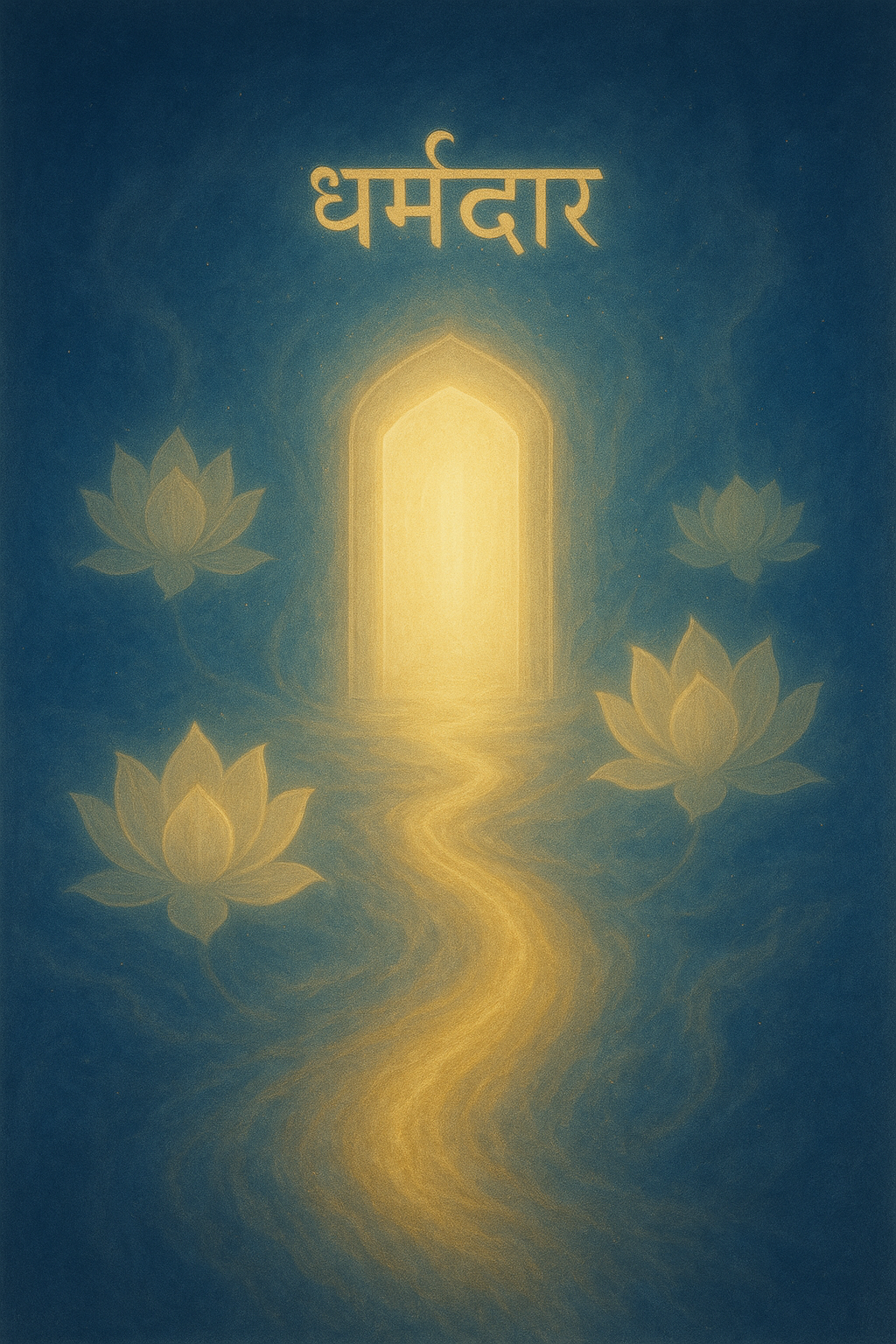
🪞 Chapter 21: The Mirror of Karma
कर्म
“Karma is the mirror in which the soul sees its own face.”
Buddhist proverb
In the Buddhist vision, the afterlife is not ruled by external judges. There is no divine figure weighing your fate.
Instead, you stand before the mirror of karma: the reflection of your own deeds, intentions, and mental formations.
Every action leaves an imprint. Every thought shapes the next unfolding. This is not punishment or reward, it is resonance.
As the bardo soul navigates the liminal states, it encounters these karmic reflections. Pleasant forms arise from compassion and generosity. Frightening visions arise from anger, greed, or delusion.
“You are not punished for your anger, you are punished by your anger.”
Buddhist teaching
But even here, the wise know: these visions are empty. They are projections of the mind.
The awakened practitioner does not cling to the beautiful or fear the terrifying. They walk through the mirror, knowing: Karma arises, and karma passes away.
⚡ TL;DR The Mirror of Karma
- Karma = Mirror
You see the effects of your past actions reflected back to you, but no one else is judging you. - Resonance, Not Punishment
The afterlife reveals the patterns you’ve shaped, without moral condemnation. - Visions Are Mind
Pleasant or frightening bardo experiences are mind-projections, not fixed realities. - Awakening Beyond Karma
The liberated soul sees through the mirror, and does not get caught in reflection. - Action Still Matters
While empty, karma shapes experience, so walk carefully, mindfully, compassionately.
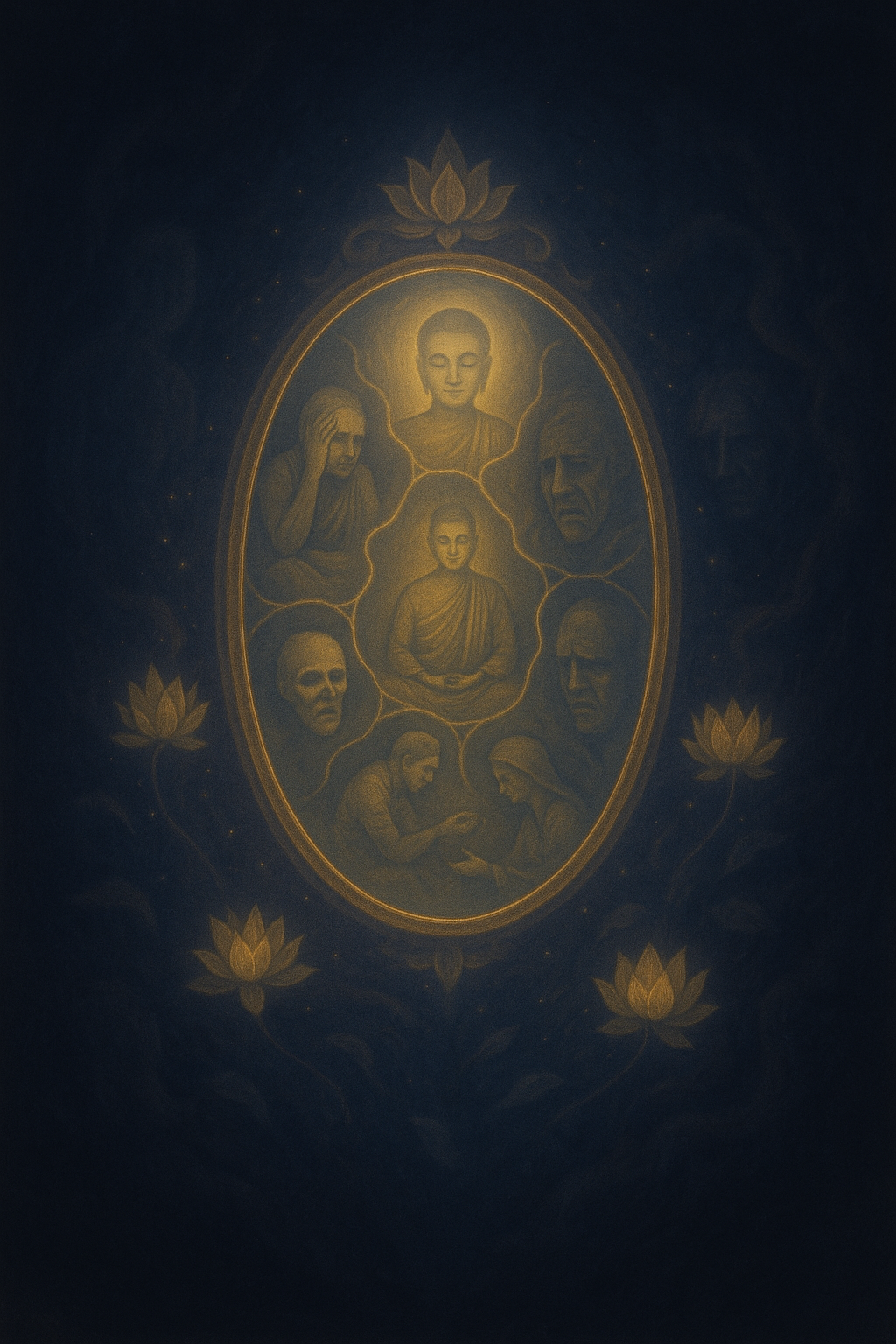
🌊 Chapter 22: The Gate of Rebirth
संसार
“Samsāra: the endless flow of birth, death, and rebirth.”
Buddhist teaching
At the end of the bardo journey, a gate waits: the Gate of Rebirth.
If the soul has not achieved liberation, if it clings to desire, fear, or identity, it is drawn back into the wheel of becoming.
This is not punishment. It is the natural momentum of karmic patterns.
The Tibetan texts describe visions at this gate: couples embracing, the pull of attraction, the surge of craving. These are not merely images, they are the karmic hooks pulling the soul into a new womb, a new life, a new cycle.
“Not in the heavens, not in the middle of the sea, not by entering a cleft in the mountains, nowhere on earth is there a place where one might escape the result of one’s deeds.”
Dhammapada 127
But for the awakened, the gate is not a trap. It is an opening.
The practitioner with gnosis does not get caught. They walk through the gate not into rebirth, but beyond it into nirvāṇa.
⚡ TL;DR The Gate of Rebirth
- Rebirth Is the Default
Without awakening, the soul is drawn back by karmic momentum. - The Gate Is Craving
Desire and attachment are the doorway into new becoming. - No External Judge
Rebirth happens naturally, not imposed by a god. - Awakening Breaks the Cycle
The liberated soul does not cling, and thus steps beyond the wheel. - Nirvāṇa Awaits
Beyond rebirth is the unconditioned, the end of becoming, the final peace.
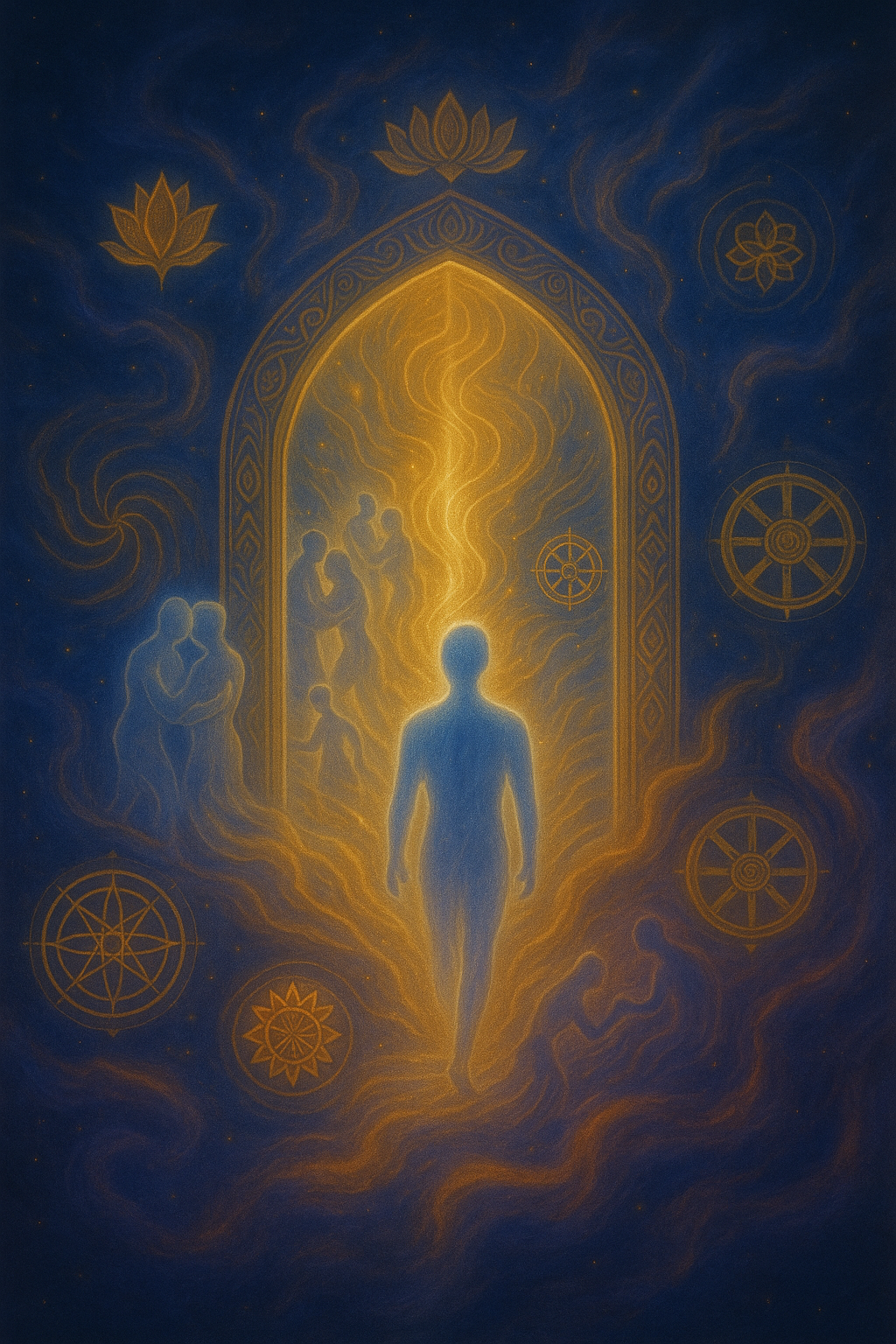
🌌 Chapter 23: Nirvāṇa and the End of Becoming
निर्वाण
“Nirvāṇa: the extinguishing, the unbinding, the peace beyond all fabrication.”
Buddhist teaching
What lies beyond the gate, if the soul does not return?
The Buddha called it nirvāṇa, a state not of annihilation, but of release.
It is the end of becoming. The extinguishing of the fires: greed, hatred, delusion.
In nirvāṇa, there is no more clinging, no more thirst, no more “I” trying to become.
The Theravāda texts speak of it as the unconditioned: that which is not born, does not arise, and does not pass away.
“There is an unborn, an unbecome, an unmade, an unfabricated. If there were not this unborn, unbecome, unmade, unfabricated, there would be no escape from the born, become, made, fabricated.”
Udāna 8.3
Nirvāṇa is not a place. It is not a heaven, or a reward. It is the end of the need to grasp, to strive, to continue.
It is peace. It is freedom.It is the ultimate cessation of suffering.
⚡ TL;DR Nirvāṇa
- Nirvāṇa = Unbinding
The extinguishing of the fires of desire, hatred, and delusion. - Not Annihilation
Nirvāṇa is not non-existence; it is the end of suffering and becoming. - The Unconditioned
It is the reality beyond birth and death, beyond all fabricated things. - Freedom Beyond Self
The ego dissolves; what remains is peace without a centre. - The Goal of the Path
All Buddhist practice aims toward this ultimate liberation.
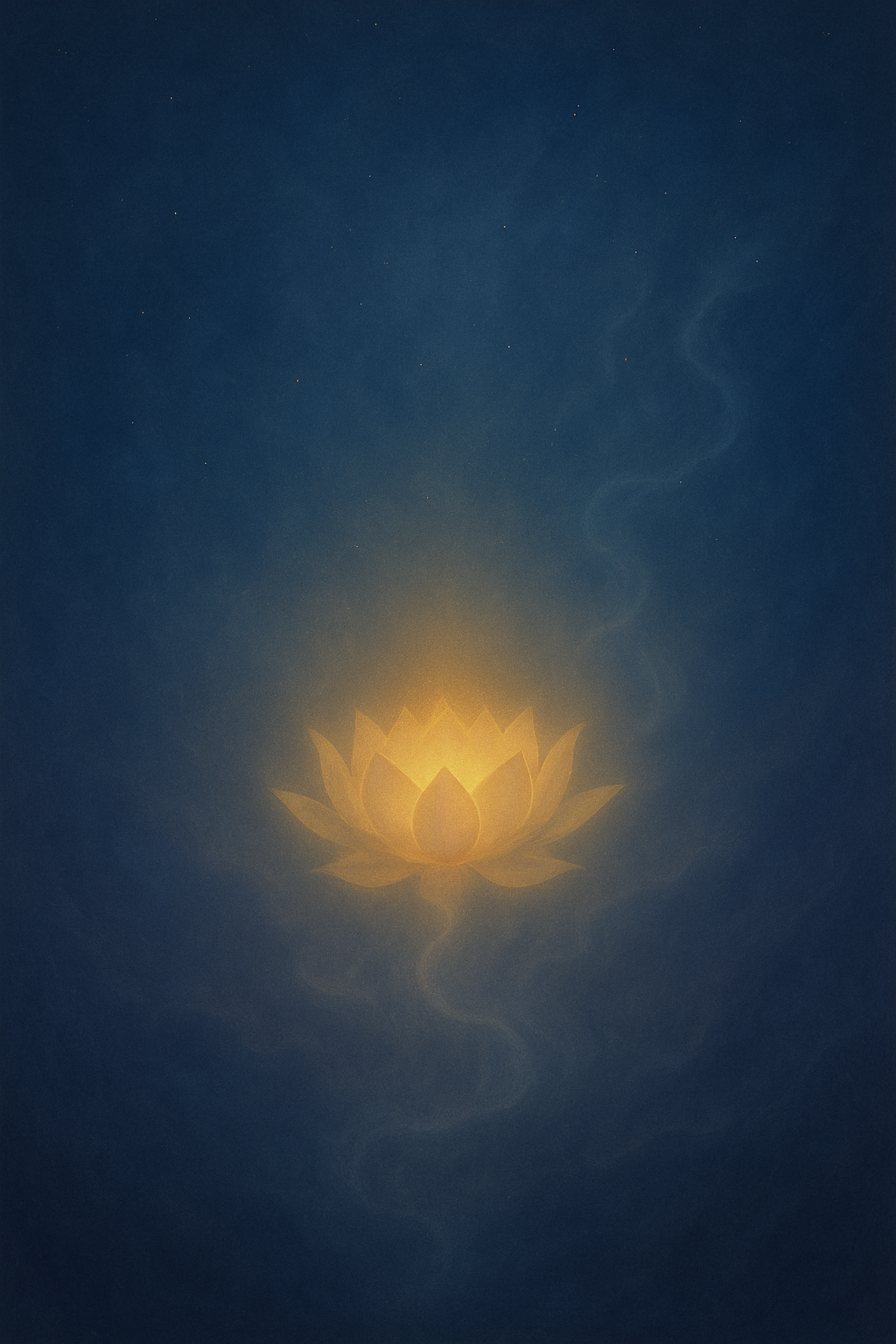
🌟 Chapter 24: The Bodhisattva’s Vow
बोधिसत्त्व
“Beings are numberless; I vow to save them. Delusions are inexhaustible; I vow to end them.”
Bodhisattva vow
In the Mahāyāna tradition, the story shifts.
Not all who stand at the gate choose to cross. Some turn back.
These are the bodhisattvas, beings who have realised the emptiness of all things, who stand at the threshold of nirvāṇa, but choose to remain in the world of suffering.
Why?
For love.
The bodhisattva sees that no being is separate. That liberation is incomplete if even one soul remains trapped in ignorance.
So they take the vow: to delay their own final freedom until all beings are free.
“The one who realises emptiness sees no difference between self and other, between nirvāṇa and saṃsāra, and thus stays in the world as a lotus in the mud.”
Mahāyāna teaching
This is the paradox of the highest path: the more the self dissolves, the more love remains.
⚡ TL;DR Bodhisattva Vow
- Bodhisattva = Enlightened Being
One who chooses to remain in the world out of compassion. - The Vow
To save all beings, end all delusions, and walk the path endlessly for others. - Beyond Self-Liberation
The bodhisattva sees no final nirvāṇa apart from the awakening of all. - Compassion Without Bound
This is the heart of Mahāyāna Buddhism, love that refuses to leave anyone behind. - The Lotus in the Mud
The bodhisattva lives in the world but is not stained by it, like a lotus blooming from the mire.
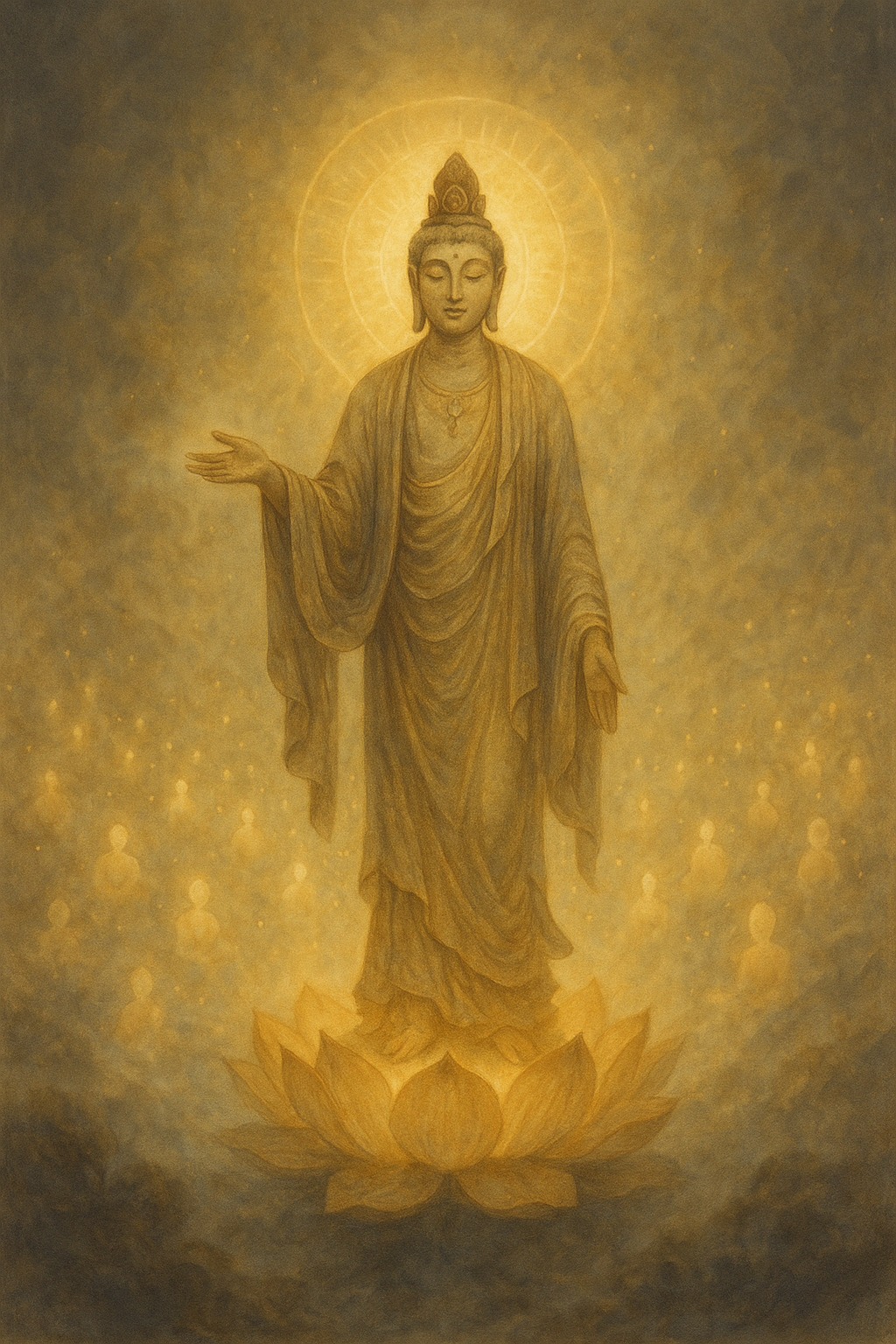
🌿 Chapter 25: Emptiness and the Clear Light
शून्यता
“Form is emptiness; emptiness is form. Emptiness is not separate from form; form is not separate from emptiness.”
Heart Sūtra
What lies at the core of all Buddhist realisation?
Not a thing. Not a god. But śūnyatā, emptiness.
Emptiness is not void, not nothingness. It is the realisation that all things lack inherent, independent existence.
Body, mind, thought, self, time, space all are woven from interdependence, arising and falling like waves on the ocean.
“All dharmas are like a dream, an illusion, a bubble, a shadow, like dew or a flash of lightning, thus should you view them.”
Diamond Sūtra
In Tibetan Buddhism, this emptiness reveals itself as the clear light, the luminous, formless awareness underlying all experience.
It is not something to be added or achieved. It is what remains when clinging stops, when self dissolves, when the mind rests in its own nature.
To realise emptiness is to awaken not into despair, but into boundless compassion, infinite openness, and the playful dance of the cosmos itself.
⚡ TL;DR Emptiness & Clear Light
- Śūnyatā = Emptiness
All things lack fixed, independent essence; they arise in interdependence. - Not Nihilism
Emptiness is fullness, the openness that makes compassion and freedom possible. - The Clear Light
The radiant, formless awareness underlying all phenomena, revealed when the mind is still. - The Heart of Mahāyāna
Emptiness and compassion are inseparable; wisdom sees the empty nature, compassion embraces the world. - The Ultimate Dance
Realising emptiness is awakening to the living, luminous play of existence.
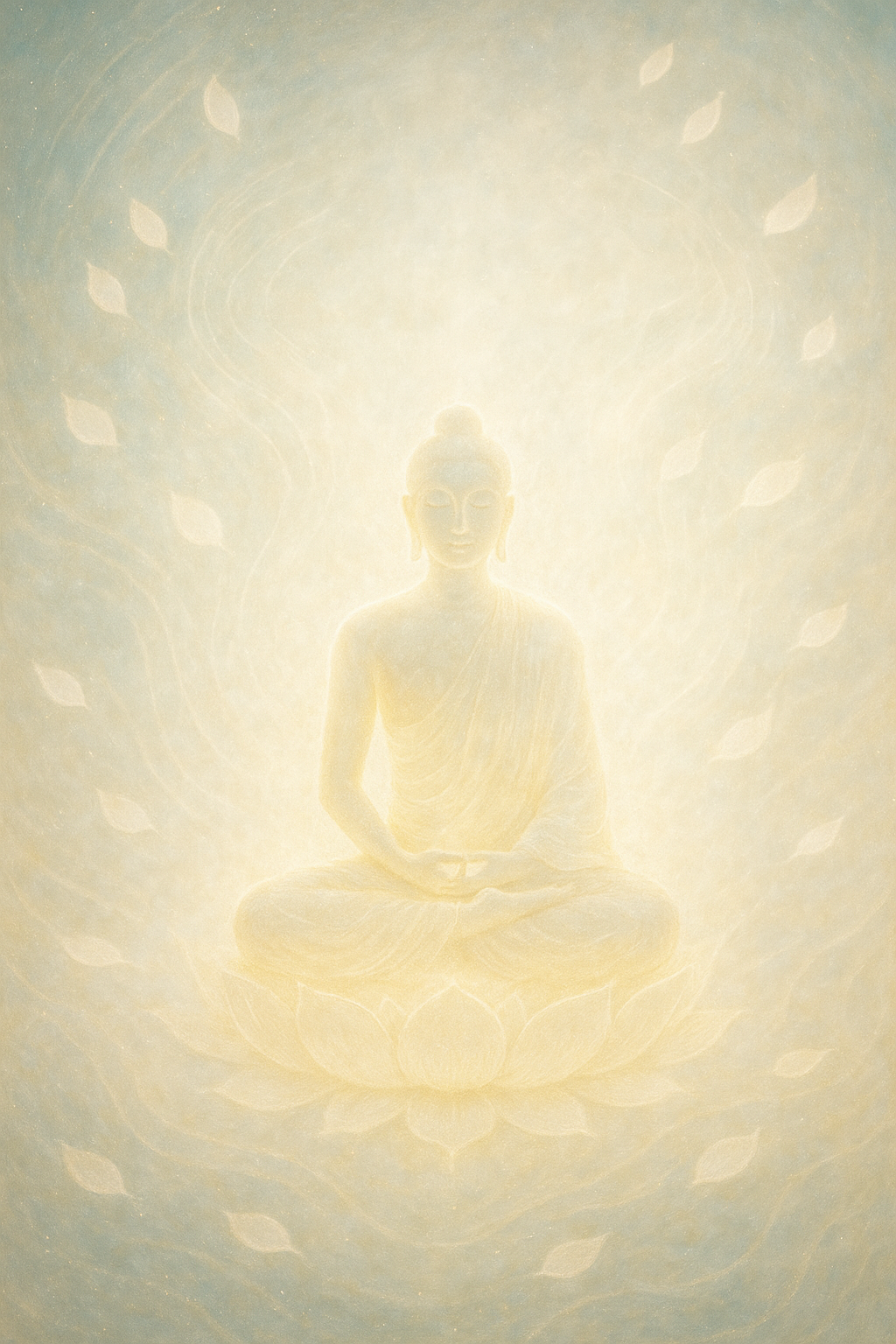
🧠 Quiz: How Fierce Is Your Compassion?
1. What is bodhicitta?
Correct! Bodhicitta is the heart-mind of awakening that vows to liberate all beings.
2. What does the bodhisattva vow involve?
Correct! Bodhisattvas vow to remain in the world, guiding others, until all are free.
3. In Buddhist symbolism, what does the lotus represent?
Correct! The lotus blossoms from the mud, symbolising awakening amid worldly struggle.
4. Reflective: Where does your compassion hesitate, and what might unfreeze it?
Insight: The bodhisattva path touches all these, compassion expands when you confront its limits.
5. Bonus Challenge: What is śūnyatā?
Correct! Craving (taṇhā) and ignorance (avijjā) perpetuate samsāra.
6. What drives the wheel of samsāra?
Correct! Śūnyatā is emptiness, the dynamic interdependence of all things, empty of fixed essence.
7. Reflective: What craving in your life feels like a karmic hook?
Insight: Recognising cravings weakens their pull, aligning with the bodhisattva path.
📖 Glossary
Decode the Language of Compassion and Emptiness
- Bodhicitta
- The awakened heart-mind dedicated to liberating all sentient beings.
- Bodhisattva
- A being who has generated bodhicitta and vows to remain in samsara to help others awaken.
- Śūnyatā
- Emptiness, the absence of inherent existence, revealing interdependence and fluidity.
- Six Pāramitās
- The six perfections: generosity, ethics, patience, effort, concentration, wisdom, the bodhisattva’s training.
- Upaya
- Skillful means; the adaptable methods bodhisattvas use to guide beings based on context and need.
🗣️ Discussion: How Fiercely Do You Love?
Where in your life could fierce compassion transform your actions?
- Who challenges your compassion most, strangers, self, or foes?
- How might small acts embody the bodhisattva’s vow daily?
- What fear blocks your heart’s openness?
Reflect or share with #TheGnosticKey on X or Telegram:
✨ The Scroll Unfolds
In Scroll III, you'll walk the Diamond Path, where wisdom cuts illusion, and compassion radiates as boundless light.
💎 Scroll III: The Diamond Path Vajrayāna’s Lightning Road, the Radiant Mind, and Death as the Gateway to Liberation
⚠️ Buddhist Diversity Disclaimer
This scroll follows the Tibetan Vajrayāna path, including teachings from the Bardo Thödol, Dzogchen, and Tantric visualisation lineages. It reflects one esoteric stream of the Dharma. Other schools (Theravāda, Zen, Pure Land) may emphasise different views on death, rebirth, and liberation. This is a diamond facet, not the whole jewel.
Previously: From Samsāra’s wheel to the bodhisattva’s return, you’ve danced through birth, death, and intention. Now the Diamond Path opens, the Vajra blade cuts illusion, and the radiant void calls the soul home.
🌌 Chapter 26: The Bardo States
བར་དོ་
“O child of Buddha nature, when the body and mind separate, you will see the pure light of the Dharma.”
Tibetan Book of the Dead
In Tibetan Buddhism, the journey after death is not a single moment, it unfolds across distinct phases known as the bardo.
Bardo means “in-between.” It refers to the transitional states between life, death, and rebirth.
The main bardo stages are:
- Chikhai Bardo — the moment of death, the dawning of the clear light.
- Chönyi Bardo — the experience of visions, deities, and karmic projections.
- Sidpa Bardo — the passage into rebirth, shaped by karma and mindstream.
These states are not just afterlife events. They mirror the processes of mind happening every moment: death of one thought, space, arising of the next.
In the bardo, a realised being can recognise the illusions, embrace the clear light, and liberate the mind from the cycle of rebirth.
“Now when the bardo of dying dawns upon me, I will abandon all grasping, yearning, and attachment, and enter undistracted into clear awareness of the teaching.”
Tibetan Book of Living and Dying
To know the bardos is to prepare, not just for death, but for the profound transitions happening in every breath.
| Bardo | Description | Opportunity |
|---|---|---|
| Chikhai | Moment of death, Clear Light dawns | Recognise light for liberation |
| Chönyi | Visions of deities, karmic projections | See illusions as empty |
| Sidpa | Pulled toward rebirth by craving | Choose clarity over attachment |
⚡ TL;DR The Bardo States
- Bardo = In-Between State
The transitional phases between life, death, and rebirth. - Three Main Bardos
Moment of death (clear light), karmic visions, and rebirth. - Mirror of the Mind
The bardos reflect inner processes happening every moment. - Opportunity for Liberation
A realised mind can use the bardos to break free from samsāra. - Preparation is Key
Familiarity with the bardos prepares the soul for a conscious death.
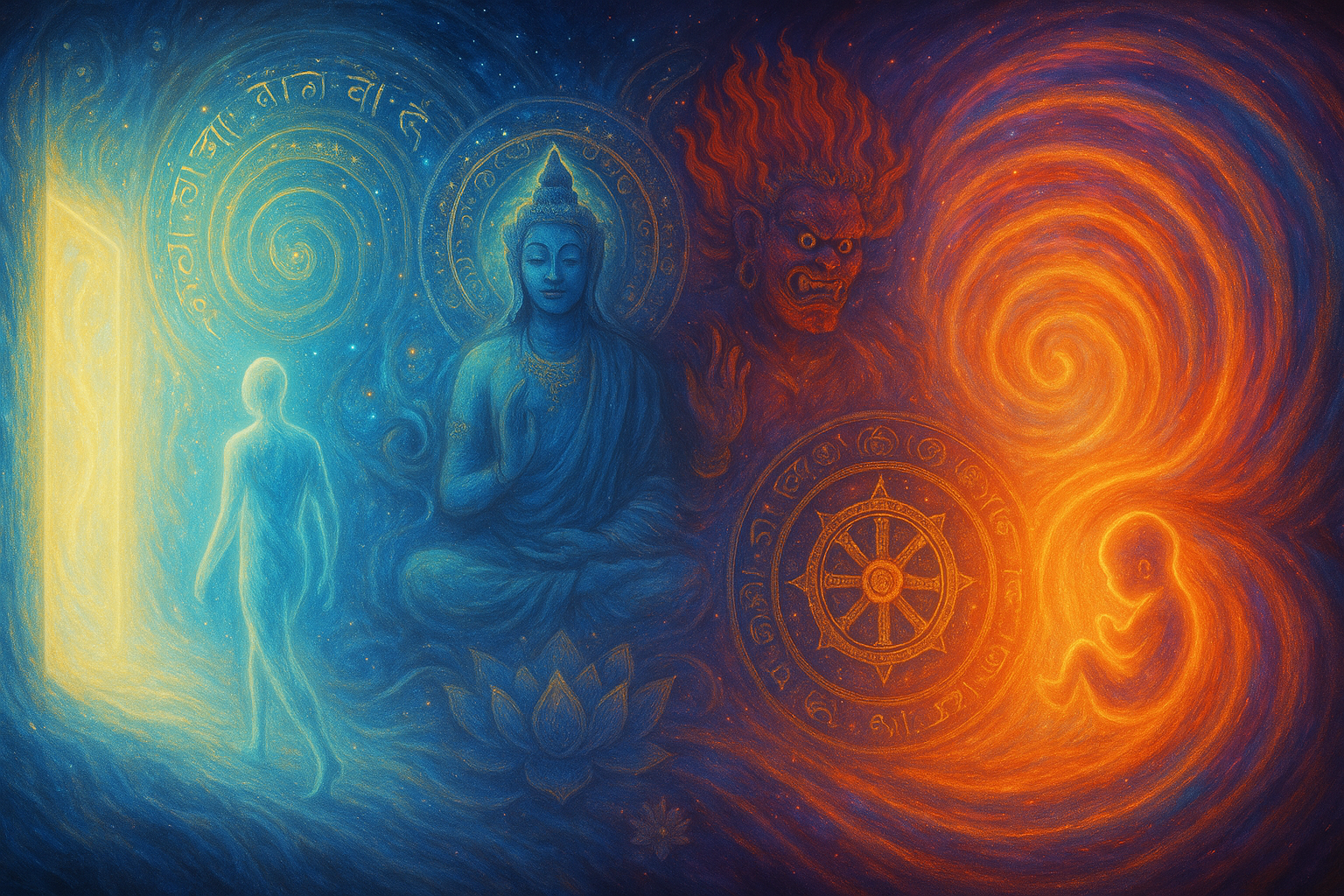
🌌 Chapter 27: The Clear Light of Death
འོད་གསལ་
“At the moment of death, the clear light dawns the radiant ground of all being.”
Tibetan Book of the Dead
According to Tibetan teachings, the moment of death reveals the clear light: a radiant, luminous awareness beyond self, beyond form, beyond duality.
This is the ultimate nature of mind, the dharmakāya, the truth body, the undivided reality.
For the unprepared, this moment passes unnoticed, like a flash too bright for recognition. But for the awakened, it is the great opportunity to merge into the light, dissolve all clinging, and achieve liberation.
“This radiant void is the beginning and end. Recognise it, rest in it, become it.”
Dzogchen Teachings
The clear light is not “after” life. It is underneath life, present in every instant, waiting to be seen.
To die well is to meet it, to surrender into its radiance, and to go beyond rebirth forever.
⚡ TL;DR The Clear Light
- Clear Light = Ultimate Mind
The luminous, nondual ground revealed at the moment of death. - Dharmakāya Nature
The truth body, beyond form and illusion, pure awareness. - Opportunity for Liberation
Recognising and merging with the clear light ends samsāra. - Preparation in Life
Training in meditation, presence, and recognition readies the soul. - Not Just at Death
The clear light is always present, awakening is available now.
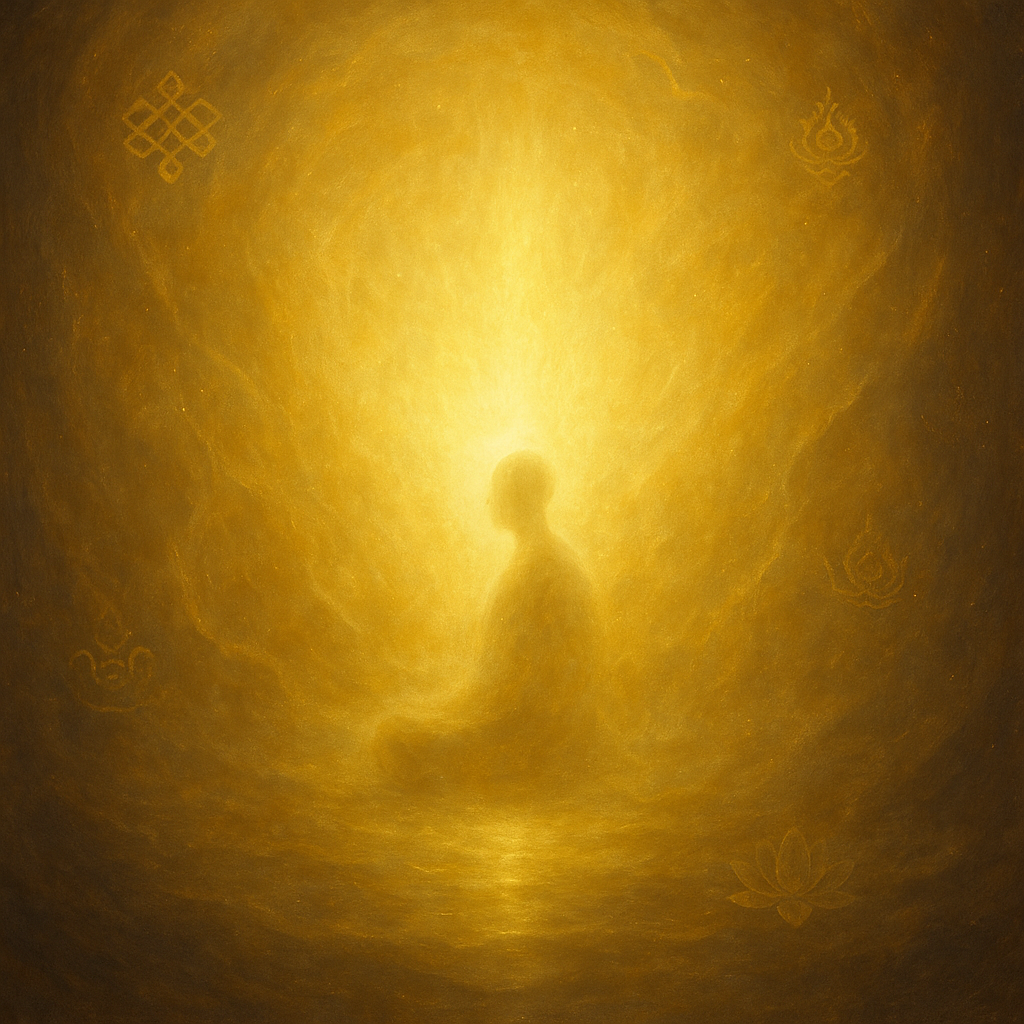
🌌 Chapter 28: The Bardo of Becoming
སྐྱེ་བརྩོན་གྱི་བར་དོ་
“In the in-between, you are neither here nor there neither dead nor reborn, but shaped by your own mind.”
Tibetan Bardo Teachings
After the clear light fades, if the soul does not merge, it enters the bardo of becoming a liminal space, a realm of vivid projections and shifting forms.
This is the stage between death and rebirth. The soul, now without a body, moves by thought, sees with karmic vision, and is pulled toward its next birth by the momentum of past desires and fears.
In this space, the mind is both creator and captive. Terrifying visions arise, not from punishment, but from reflection. Beautiful visions arise, not as reward, but as mirror.
“Mind is the maker. What you cling to becomes your world.”
Bardo Thödol
Those who remember, who stay present, who do not chase or flee, can still awaken here, and break free from the wheel of rebirth.
⚡ TL;DR Bardo of Becoming
- What It Is
The transitional state between death and rebirth, filled with vivid karmic visions. - Mind Shapes Reality
The soul creates and experiences its own projections based on past attachments. - Clinging Drives Rebirth
Desires and fears pull the soul toward a new incarnation. - Chance for Awakening
Even here, presence and recognition can break the cycle. - Key Practice
Stay aware, stay unattached, remember your true nature.
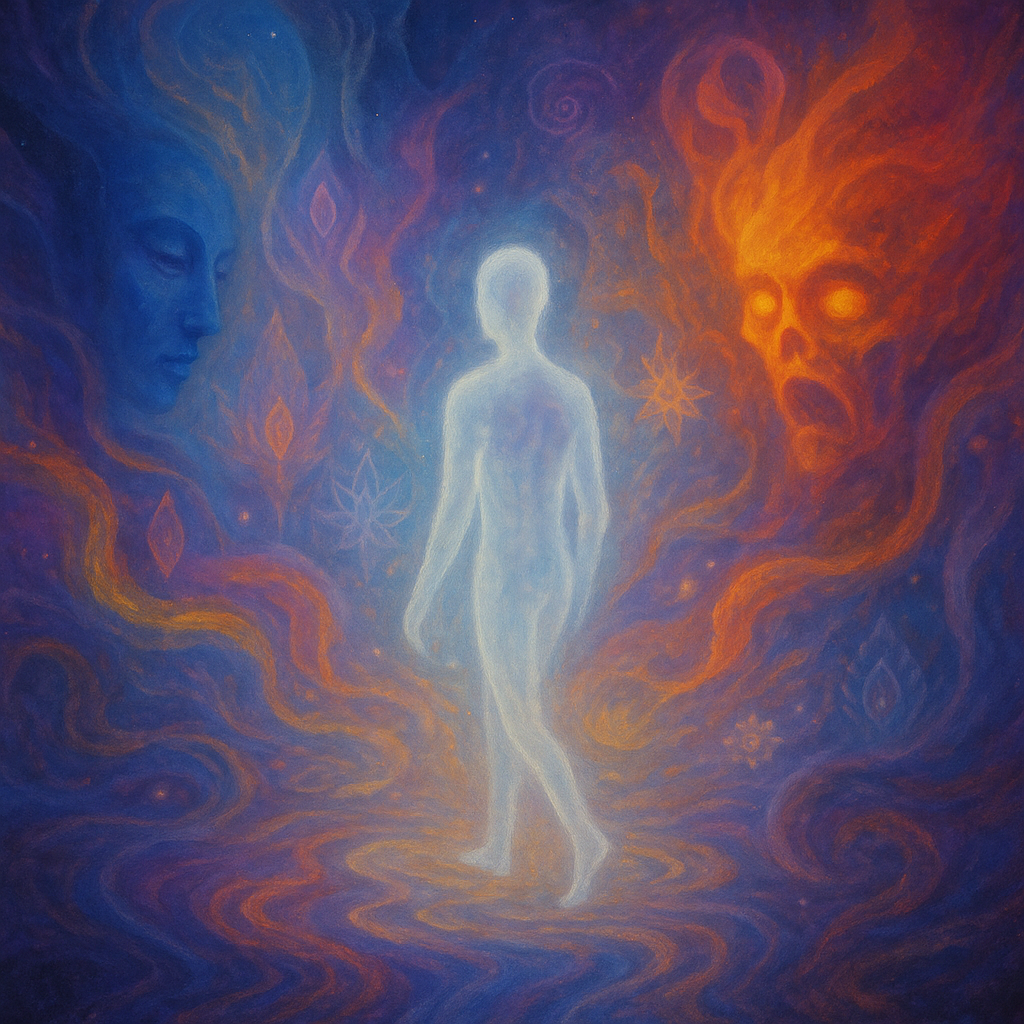
🌌 Chapter 29: Karmic Threads and the Wheel of Rebirth
ལས་ཀྱི་རྒྱུ་འབྲས།
“Whatever one has done, wholesome or unwholesome one is bound to experience.”
Tibetan Karma Teachings
As the soul drifts in the bardo of becoming, its karmic momentum begins to shape its path.
Past actions, intentions, desires, and aversions weave a tapestry, pulling the soul toward forms, parents, conditions, and worlds that resonate with its inner patterns.
This is not judgement. It is resonance.
The seeds you plant bloom here. The patterns you feed shape your next body. You are not sent. You are drawn, by the gravity of your own mind.
“From intention arises karma. From karma, becoming. From becoming, birth.”
Dependent Origination, Buddhist Sutras
To awaken here is to untangle the threads. To see that the pull is optional. That the wheel can be stepped off, if the soul remembers the silence beyond story.
⚡ TL;DR Karmic Threads
- What It Is
Karma: the momentum of past actions pulling the soul toward rebirth. - Not Punishment
No one assigns a birth, the soul resonates into it. - Seed and Fruit
Every thought, word, and deed plants karmic seeds that ripen later. - The Wheel
The cycle of birth and death (saṃsāra) turns on karmic propulsion. - Exit Path
To step off the wheel, the soul must cut the threads: craving, clinging, aversion, illusion.
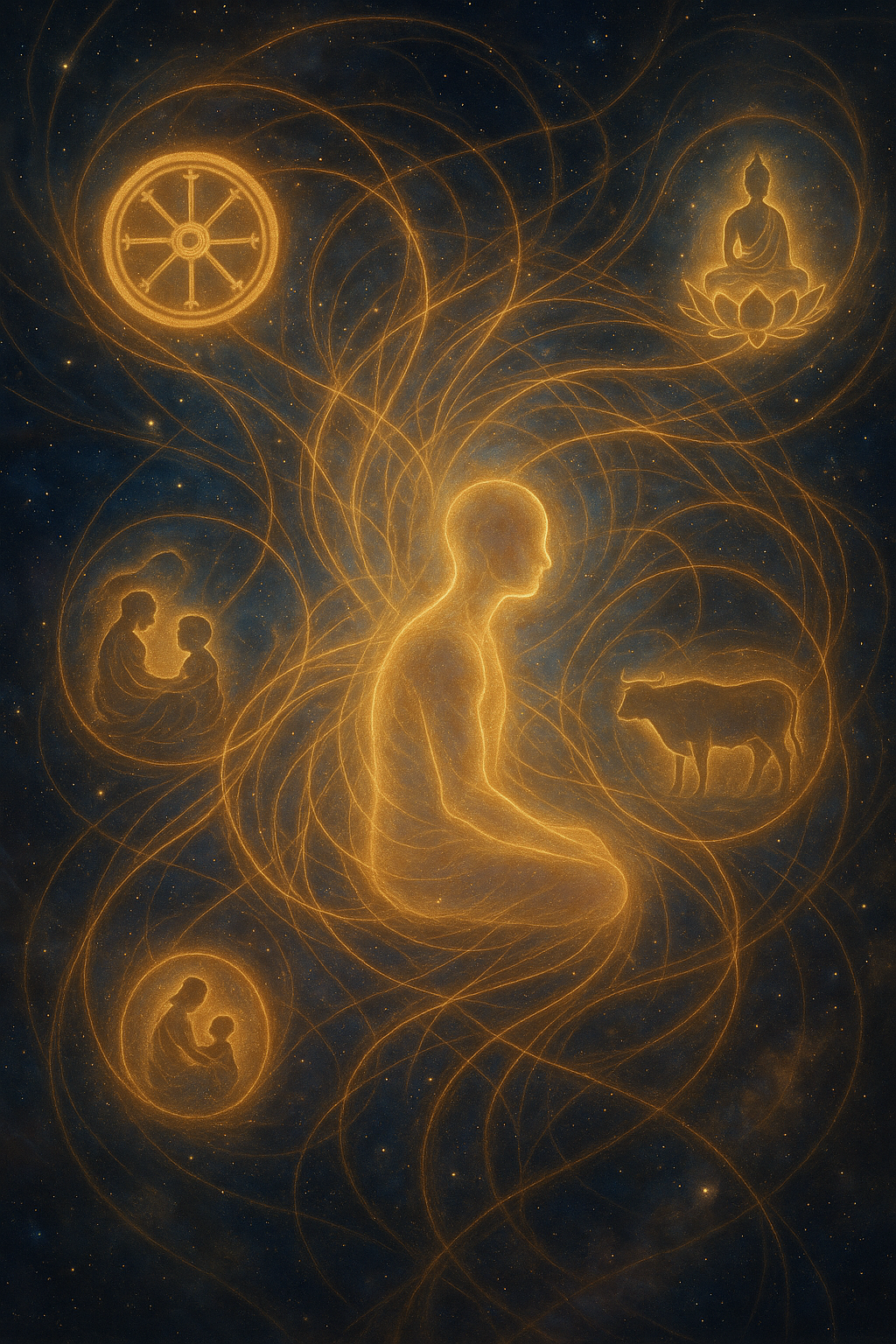
🌌 Chapter 30: The Moment of Choice at the Threshold
“Viññāṇaṃ paṭisandhāya”
“Consciousness binds itself again.”
Pali Canon, Rebirth Teachings
In the final stretch of the bardo, the soul approaches the threshold of rebirth.
Visions flash, parents, lands, forms, desires, each calling the soul toward embodiment.
This is not a rational choice. It is instinct, craving, pull. A dance of resonance, not reason.
In Tibetan teachings, the Delok (those who return from death) speak of this moment as the point of no return the moment when the mind, unguarded, leaps.
And yet… here too is the gate. If mindfulness has been cultivated, if gnosis arises, the soul can see the trap before entering.
This is the razor’s edge: To enter with craving, or with clarity. To fall, or to rise.
“Who knows the nature of becoming, escapes becoming.”
Tibetan Bardo Teachings
⚡ TL;DR The Threshold Moment
- What Happens
The soul encounters visions of parents and forms, karmic ties drawing it toward rebirth. - The Point of No Return
Once attachment forms, the soul binds to a new womb or realm. - Clarity or Craving
Mindful awareness here can break the momentum; craving seals rebirth. - The Razor’s Edge
This is the final, decisive moment in the bardo journey, before form is assumed again. - Mastery
Great practitioners navigate this space with lucidity, choosing liberation over cycle.
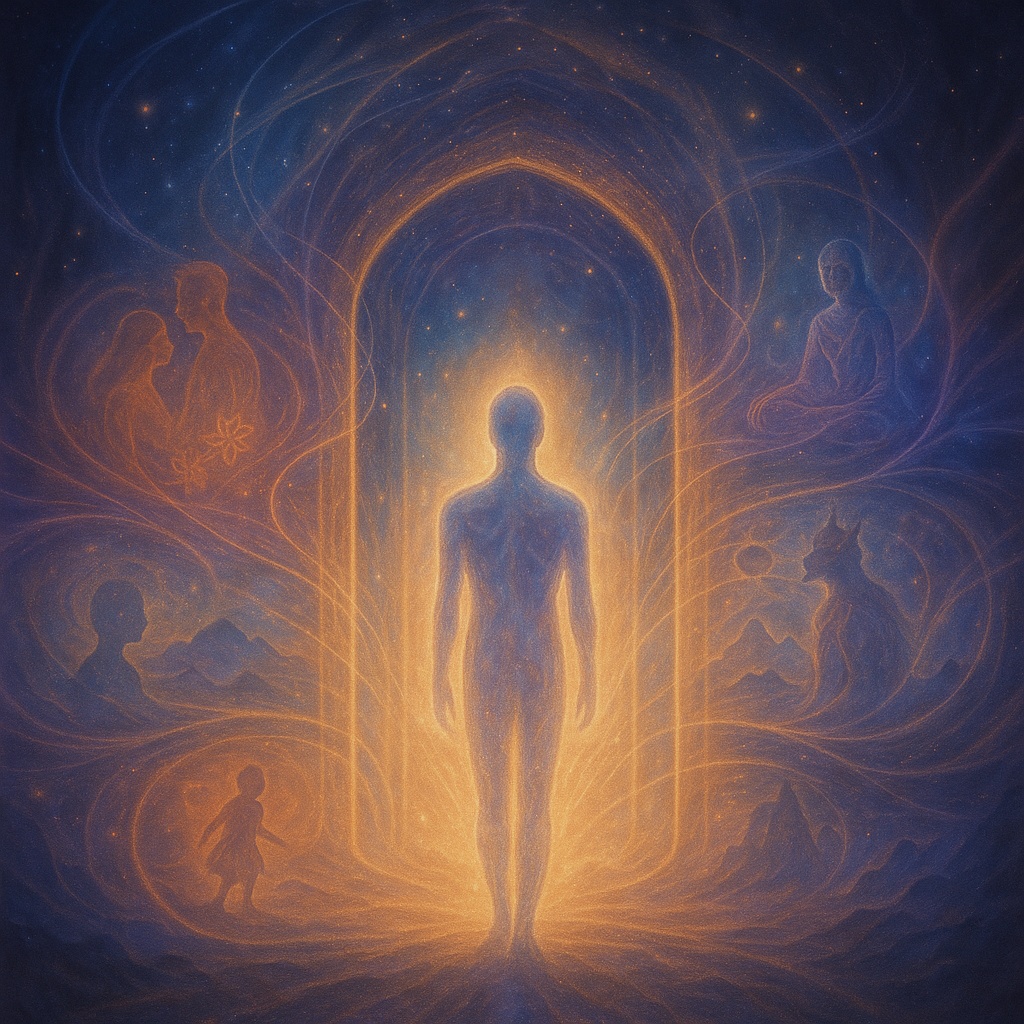
🌌 Chapter 31: The Liberation Path
དགེ་འདུན་ཞེས་བྱ་བའི་སྐུ
“The Sangha, those who have gone beyond.”
Tibetan Bardo Teachings
For the soul who has cultivated gnosis, who has sharpened mindfulness, the bardo is not a trap.
It is a pathway of light.
The Tibetan texts speak of the clear light of the void, the luminous ground of being, the open radiance that offers direct liberation if the soul can recognise and merge with it.
This is not easy. Even for trained practitioners, the pull of karma is strong. But the teachings say: at the moment of choice, if the soul recognises its own nature as light, it dissolves into freedom.
“Rest in the clear light. Recognise it as your own mind. And be free.”
Tibetan Book of the Dead
This is nirvāṇa, not an escape, but a return to unconditioned being.
The wheel stops. The veils fall. The radiant emptiness shines as the soul’s true face.
⚡ TL;DR Liberation in the Bardo
- The Clear Light
The ultimate opportunity for liberation, the luminous void appearing after death. - Recognise and Rest
Realising the clear light as one’s own nature leads to freedom from rebirth. - The Master’s Path
Highly trained practitioners prepare for this moment over lifetimes. - Beyond the Wheel
Liberation is not annihilation, it is awakening into unconditioned being. - This Is Nirvāṇa
The cessation of craving, becoming, and illusion; abiding in luminous truth.
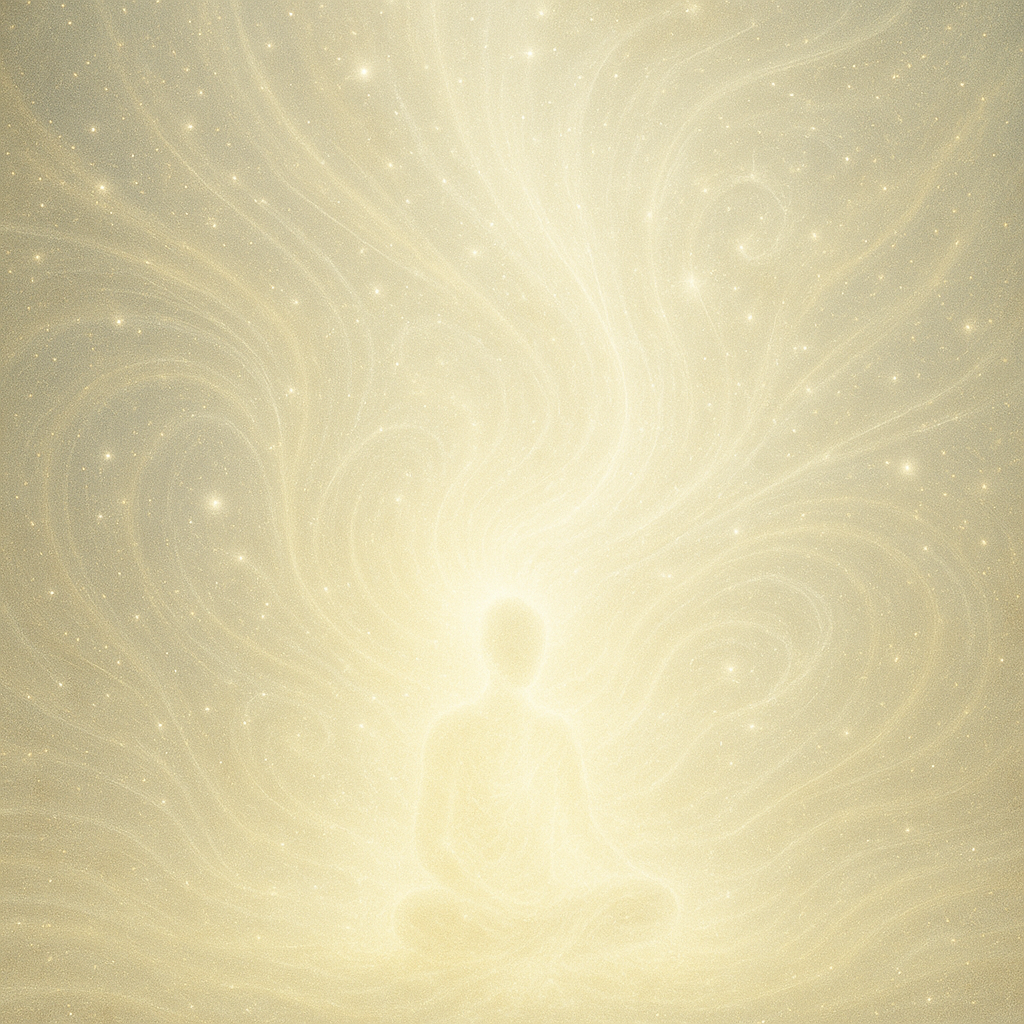
🌌 Chapter 32: Returning to the Wheel
སྐད་ཆའི་དབང་པོ་འདུལ་བ་
“The winds of karma pull the mind where it is bound.”
Tibetan Bardo Teachings
Not all souls recognise the clear light.
For many, the pull of memory, attachment, and karmic traces draws them back into saṃsāra, the wheel of birth, death, and rebirth.
The Bardo Thödol describes the soul’s journey: drifting through visions, magnetised by desire or fear, encountering symbolic wombs, and ultimately choosing, or being drawn, into a new form.
This is not punishment. It is momentum.
What you clung to in life becomes the seed of your next becoming.
“You will go wherever your karma takes you, like a feather in the wind.”
Tibetan Saying
For the unawakened, the wheel spins on. But every life carries the chance to break free, to prepare, to meet the clear light with open eyes next time.
⚡ TL;DR Return to Rebirth
- Missing the Clear Light
If the soul does not recognise its nature, it is pulled back into saṃsāra. - Karmic Gravity
Desire, fear, and attachment shape the next rebirth. - Symbolic Wombs
The soul encounters choices, visions, and pulls that lead to a new body. - Not Punishment
Rebirth is the natural unfolding of unresolved patterns. - Next Opportunity
Each life carries another chance to awaken and prepare for liberation.
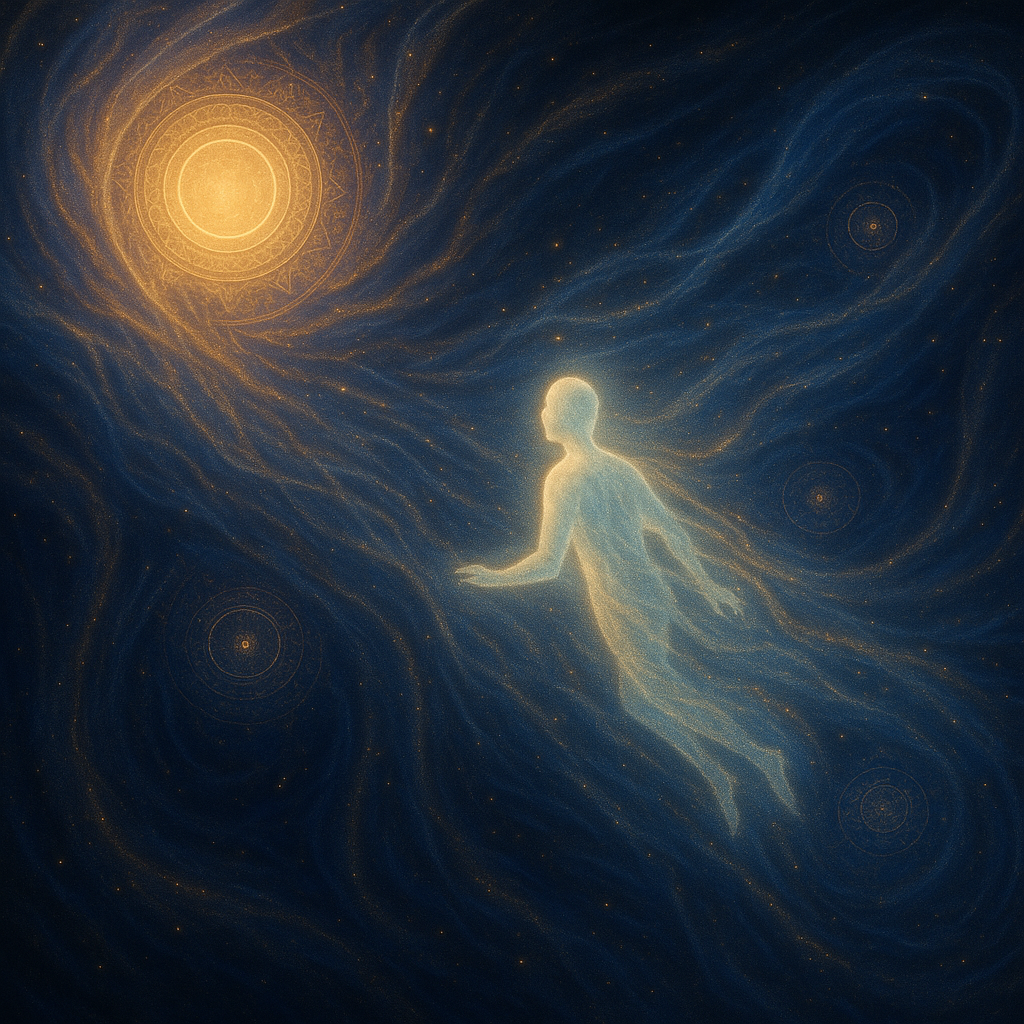
🌺 Chapter 33: Preparing Now
མ་གཏོགས་ནས་མི་ཐོབ་པ་
“Without preparation, nothing is attained.”
Tibetan Bardo Teachings
The Bardo teachings are not only for the dead. They are a manual for the living.
Every meditation, every mantra, every act of mindfulness is preparation for the moment the body falls away.
The living practitioner strengthens familiarity with:
- The Clear Light — recognising luminous awareness even now
- Letting Go — loosening the grip of attachment and fear
- Karmic Release — dissolving unskillful patterns before death
- Compassion — widening the heart to include all beings
- Presence — meeting each moment as a rehearsal for the Bardo
In this way, death becomes not a terror, but a continuation of practice. A known landscape. A gate not feared, but passed through with awareness.
“If you die before you die, when you die, you will not die.”
Tibetan Saying
⚡ TL;DR Prepare Now
- Practice Is Preparation
Meditation and mindfulness are rehearsals for the Bardo. - Awaken to the Clear Light
Familiarity with pure awareness helps at death. - Let Go in Life
Releasing attachments lightens the karmic load. - Live as a Dying Being
Each moment is a preparation for crossing the threshold. - Fear Transforms
With practice, death becomes part of the path, not the enemy.
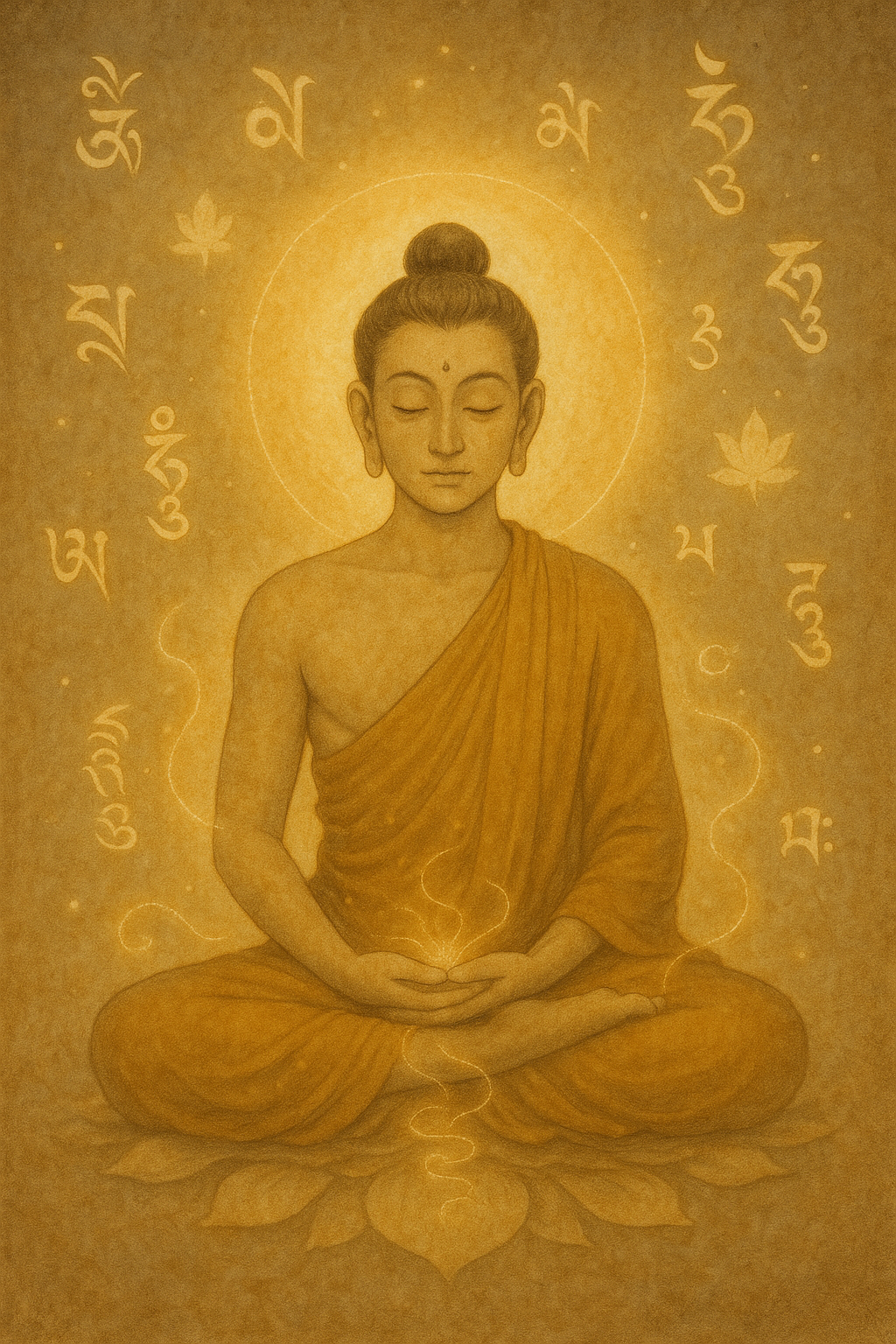
🌌 Chapter 34: Beyond the Wheel, Nirvāṇa & Liberation
མྱང་འདས་
“Nirvāṇa: beyond sorrow, beyond becoming.”
Buddhist Canon
The Bardo journey is not just about surviving the afterlife. It points toward the ultimate freedom: Nirvāṇa.
Nirvāṇa is not heaven. It is not a place. It is the extinguishing of the fires of craving, aversion, and delusion, the cessation of the wheel itself.
In the Bardo, if the practitioner recognises the nature of mind, the radiance of the Clear Light, the emptiness of all appearances they dissolve into Nirvāṇa, beyond rebirth, beyond becoming.
For the awakened, the Bardo is not a trap. It is a threshold.
“When you realise the nature of mind, you are freed from the ocean of suffering.”
Tibetan Bardo Text
⚡ TL;DR Nirvāṇa & Liberation
- Nirvāṇa Is Freedom
It is the end of cyclic existence, not a reward place. - The Bardo as Gateway
The Clear Light offers a portal to liberation if recognised. - Craving Falls Away
Without grasping, rebirth has no hook. - Ultimate Escape
The practitioner dissolves into pure awareness beyond form. - The End of Becoming
There is no more “next”, only radiant peace.
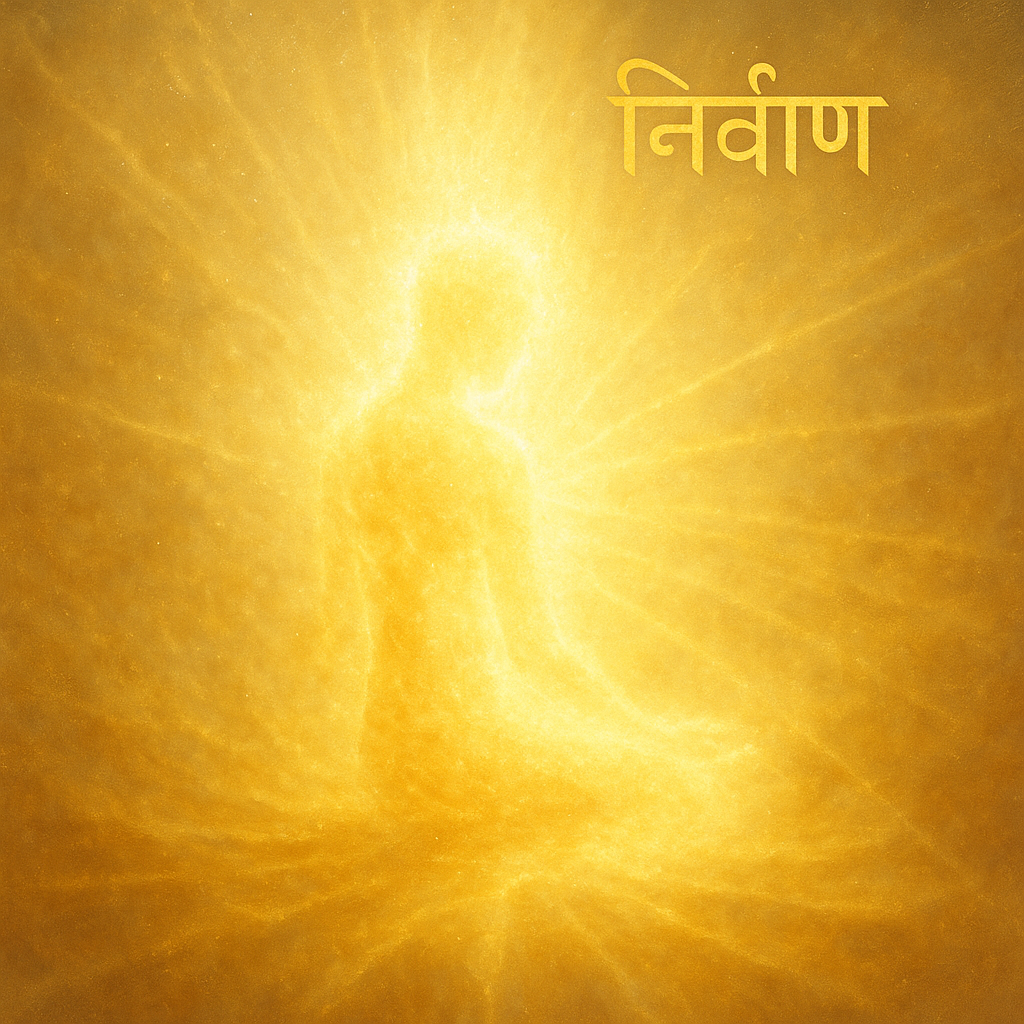
🌟 Chapter 35: The Dance of Return, Bodhisattva & Compassion
བྱང་ཆུབ་སེམས་པ།
“The Bodhisattva returns, not because they must, but because they choose to.”
Mahāyāna Sutras
Not every awakened being dissolves into Nirvāṇa. Some choose another path: the path of the Bodhisattva.
The Bodhisattva vows to remain in the cycle, not out of attachment, but out of compassion.
They dance through the Bardo, guiding the lost, whispering truth to the fearful, extending a hand to those trapped in terror.
“Sentient beings are numberless; I vow to save them all.”
Bodhisattva Vow
This is the highest paradox: to awaken fully, and yet return for the sake of others.
In Mahāyāna Buddhism, the Bodhisattva becomes a bridge, crossing between Nirvāṇa and Saṃsāra, carrying the light of liberation into every shadowed place.
⚡ TL;DR Bodhisattva Path
- Bodhisattvas Choose Return
They postpone final Nirvāṇa to help all beings awaken. - Compassion as Power
Their motivation is boundless love, not duty or karma. - They Navigate the Bardo
Not trapped, but as liberators. - Bridge Between Realms
They cross freely between Saṃsāra and Nirvāṇa. - The Ultimate Vow
Until every being is free, they will remain.
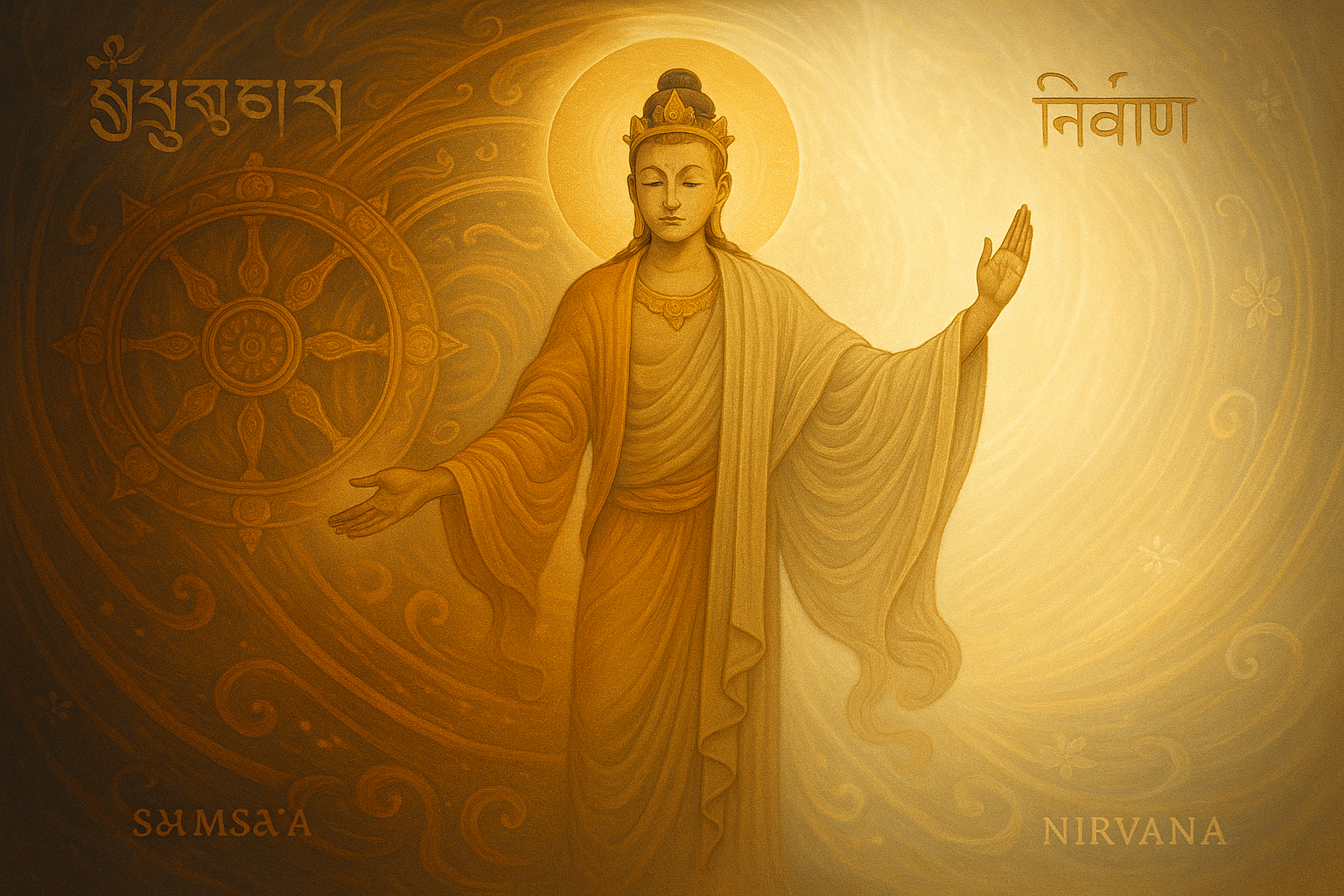
🛠️ Practicing Buddhist Awareness Today
To step off the wheel, practice must begin now in breath, intention, and compassion. These three daily tools prepare the soul to meet the bardo awake:
- Anicca Meditation
Sit for 5–10 minutes in stillness. Observe the breath and body. Whisper gently: “Impermanent.” Watch sensations rise and fall. Let go. - Karma Journaling
Each evening, reflect on a single deed. Ask: “What seed did I plant today?” Use a 21-day Karma Log:
Date | Action | Intention | Possible Fruit - Metta Breath
Inhale deeply for 4, exhale for 4. Whisper: “May all beings be free.” Send it to yourself, loved ones, strangers, enemies. Five minutes. Every day.
These practices soften karma, widen compassion, and strengthen recognition. They are the bodhisattva’s tools, for liberation now and after death.
🧠 Quiz: Can You Walk the Diamond Path?
1. What does the Vajrayāna (“Diamond Vehicle”) symbolise?
Correct! Vajrayāna is the “Diamond Vehicle”, sharp, luminous, and transformative.
2. What is a yidam in Tibetan Buddhism?
Correct! A yidam is a chosen meditation deity that helps transform the practitioner’s mind.
3. What is the bardo in Tibetan afterlife teachings?
Correct! The bardo is the “in-between”, the transitional state after death and before the next life or liberation.
4. Reflective: What illusions are you ready to cut through in your own life?
Insight: The Diamond Path is sharp, it cuts through every layer of illusion we cling to.
5. Bonus Challenge: What is the ultimate goal of Vajrayāna practice?
Correct! Vajrayāna aims for rapid enlightenment using powerful, skilful methods, a lightning path of awakening.
📖 Glossary
Decode the Diamond Teachings
- Vajrayāna
- The “Diamond Vehicle”, a swift, esoteric Buddhist path using ritual, deity practice, and skilful means to achieve awakening.
- Yidam
- A personal meditation deity embodying enlightened qualities; central to Vajrayāna visualisation practices.
- Bardo
- The transitional state between death and rebirth; a key focus in Tibetan afterlife teachings.
- Skilful Means (Upaya)
- The creative use of teachings and methods adapted to each being’s needs, guiding them toward enlightenment.
- Clear Light
- The ultimate, luminous nature of mind revealed at death, the radiant field of awakening.
🗣️ Discussion: How Sharp Is Your Diamond?
“What edge of illusion are you ready to cut through, and what diamond wisdom do you carry into the bardo?”
Reflect or share in our Circle:
- Where do you cling most tightly, to form, identity, or control?
- What would it mean to meet death as a conscious practitioner?
- How can the Diamond Path sharpen your practice today?
🎨 Creative Prompt: The Bardo’s Vision
Write a poem or sketch a scene imagining your journey through the bardo. What visions arise deities, fears, or light? What pulls you toward nirvāṇa?
Want to share it?
✨ The Scroll Unfolds
This completes the Buddhist Afterlife Trilogy, but your journey continues.
Next awaits the mystical death maps of the Egyptians, the Aztecs, and beyond, secret gates, soul tests, and cosmic reckonings.
📚 Buddhist Study & Source Texts
For those who wish to deepen their understanding of Buddhist teachings on death, rebirth, and liberation, the following texts provide both meditative clarity and doctrinal foundation.
🔍 Recommended Reading
- The Dhammapada — A foundational Theravāda scripture, filled with direct teachings of the Buddha on karma, death, and liberation.
- The Pali Canon (Tipiṭaka) — The authoritative Theravāda collection covering the Buddha’s discourses, monastic rules, and deep metaphysical doctrine.
- The Tibetan Book of the Dead (Bardo Thödol) — A sacred guide through the intermediate state (bardo) between death and rebirth, central to Vajrayāna teachings.
- The Life of Milarepa — A legendary Tibetan text chronicling the journey of a sorcerer—turned—saint who achieves enlightenment in one lifetime.
- The Heart Sutra — A core Mahāyāna text on emptiness and form, often recited during transition rites and meditative practice.
📖 Sources & Translations
- Mitchell, D. W. (Trans.). (2002). The Tibetan Book of the Dead. HarperSanFrancisco.
- Narada Thera. (1959). The Dhammapada. Buddhist Publication Society.
- Conze, E. (1958). The Heart Sutra. Buddhist Publishing Group.
- Evans-Wentz, W. Y. (Ed.). (2000). The Tibetan Book of the Dead: The Great Liberation. Oxford University Press.
- Chang, G. C. & Edman, C. A. M. (Trans.). (1989). The Hundred Thousand Songs of Milarepa. Shambhala Publications.
🌌 Continue the Journey
You’ve crossed the bardo. Faced mirrors of karma. Touched the clear light and turned the wheel.
This was not the end. It was training.
Every moment forward is a choice: to forget again, or to walk as one already free.
But this is only one facet of a greater revelation. The Gnostic Key’s Afterlife Series guides seekers through soul maps from across the world, where each tradition holds a piece of the code.
Explore the next gates:
- Gnostic Christianity — Christ the Revealer and the Map of Return
- Sufi Islam — Barzakh, the Beloved, and the Spiral Path
- Jewish Kabbalah — Ascent Through the Sefirot and the Breath of Binah
- Buddhist Afterlife — Karma, Bardo, and the Diamond Path
- Ancient Egypt — The Akh, the Scales, and the Star Map
- Mesoamerica, Xibalba, Sacrifice, and the Spiral of Time